THE excavations at Beisan, the ancient Beth-shan, were recommenced on August 27, 1928. The staff for the 1928 season consisted of Dr. I. Ben-Dor as archæological assistant, Mrs. Alan Rowe as recorder of antiquities, Mrs. A. Bomberg as secretary, Messrs. C. Kent and O. Avedissian as draughtsmen, Ahmed Effendi Abd El-Aziz as surveyor, Mr. G. Kavouksorian as bookkeeper and general assistant, and Fadil Effendi Saba as photographer. The workmen were under the control of Reis Saleh Abd El-Nabi who comes from Qift in Upper Egypt and who has been associated with the Expedition since 1926.
The excavations of the present season have been carried out in the following city-levels on the tell: (1) in the Thothmes III level; (2) in the pre-Amenophis III level; (3) in the Amenophis III level; (4) in the Seti I level, immediately to the west of the area where the Seti I temple, now cleared away, once stood; and (5) in the Rameses II level, in the western part of the fort. It is pleasing to be able to state that the antiquities discovered in all these areas have been particularly interesting and are really more important than those found on the tell during the 1927 season; and that the season’s excavations have resulted in discoveries which are of the utmost importance for the ancient history of the Land of Canaan.

No. IX City-Level. Thothmes III: 1501-1447 B.C.
The whole temple of Mekal has now been excavated and we are thus enabled for the first time to get a correct and full idea of its general plan. It is therefore necessary to make a few corrections in the provisional plan published in the MUSEUM JOURNAL, June, 1928, p. 169; the most important alterations being the removal of the “wall”, which is now seen to have been but a mass of stones and debris, to the west of the so-called “corridor” leading to the northern temple, and the removal of the so-called “anteroom”. The plan accompanying this report now shows the final details of the temple and also the details of the great outer fort wall to the south of the level and of the new rooms excavated to the west and east of the temple.
The Temple of Mekal
Including the discoveries of this season with those of the last season, we see that the Mekal temple consists of : (1) A great courtyard to the west of the inner sanctuary. The entrance to the courtyard is on its western side, while the entrance to the inner sanctuary from the courtyard is near the southeastern corner of the latter place, adjacent to the wooden pole upon which, perhaps, the skin of a sacrificed animal was hung. This pole, which may be compared with the poles found near the temple of Amenophis III and published in the MUSEUM JOURNAL, June, 1928, p. 153, served the same purpose as the pole with the skin of a sacrificed calf attached, shown in the uppermost vignette on the coffin of the priest [Nesi-]Neb-Neteru in the UNIVERSITY MUSEUM. (2) An inner sanctuary containing a stone altar for meat offerings and a brick stepped altar for cult objects, etc. (3) A room south of the inner sanctuary containing the great stepped altar of sacrifice, etc. This recalls a stepped slaughter-house mentioned in a Punic inscription from Carthage.1 (4) A room, east of the inner sanctuary, containing a great circular oven for roasting the animals slaughtered upon the altar of sacrifice. (5) A well, 43 feet deep, to the east of the oven room, used for supplying water to the temple. (6) A southern corridor which, being on a higher level than the courtyard, has a flight of steps leading up to it from the courtyard. (7) A great stepped altar, 16 feet 10 inches wide, in the western end of the southern corridor. (8) A small room situated behind the great stepped altar, containing two mastabahs or seats and a socket for a peg to which was probably tethered an animal. (9) A small room containing the mazzebah or sacred conical stone, emblematic of Mekal, at the eastern end of the southern corridor. Even to this day, in Beth-shan the natives regard with some respect a certain stone column upon which they sacrifice small animals in fulfilment of vows made in the tomb enclosure of Sheikh Halabi, a local saint. This column, which dates apparently from the Roman period, is situated just outside the tomb. Nos. (2), (3) and (9) have been fully described in past reports and so, like the room north of the inner sanctuary, do not require to be dealt with here. The courtyard (No. 1) and the southern corridor (No. 6) have also been partially dealt with but must be referred to again as they are now fully cleared.
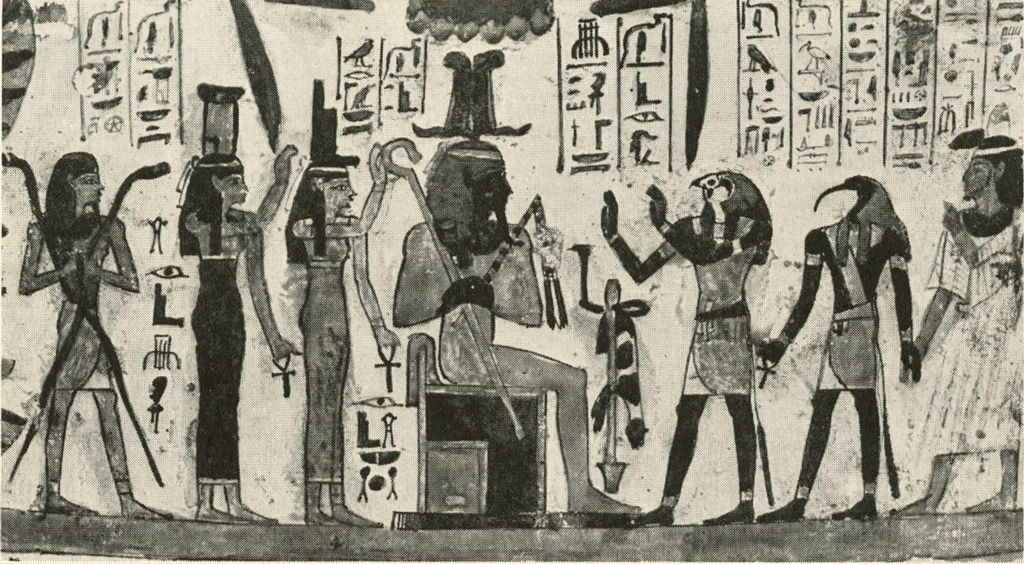
The Courtyard of the Mekal Temple
The courtyard of the Mekal temple, which temple, following the Arabs, we may well call Haram esh-Sherif, “The Noble Sanctuary”, is of great and imposing proportions. Its maximum measurements are 82 feet from east to west and 114 feet from north to south. In ancient days, no doubt, the bulls to be sacrificed were adorned with the heavy bronze bull-and-lion pendant found in the 1927 season2 and were led about in the courtyard in order that laymen might see and admire the animals to be offered up to the great Baal of the city, for the courtyard was the only part of the temple accessible to laymen. The head of a bull was found as an offering in a burial chamber of the Vth Dynasty at Beni Hassan3 and in a small chamber in the tomb shaft of the recently discovered tomb of Hetep-heres, the queen of Seneferu, at Giza. As I have already observed in a previous report, some bones and the horns of a bull were discovered in the Mekal temple at Beth-shan in the 1927 season, and parallels with Egyptian ceremonies and concepts involving the sacredness and even the divinity of the bull at once suggest themselves. Compare, for instance, the famous ceremony of ” The Running Round of Apis”.
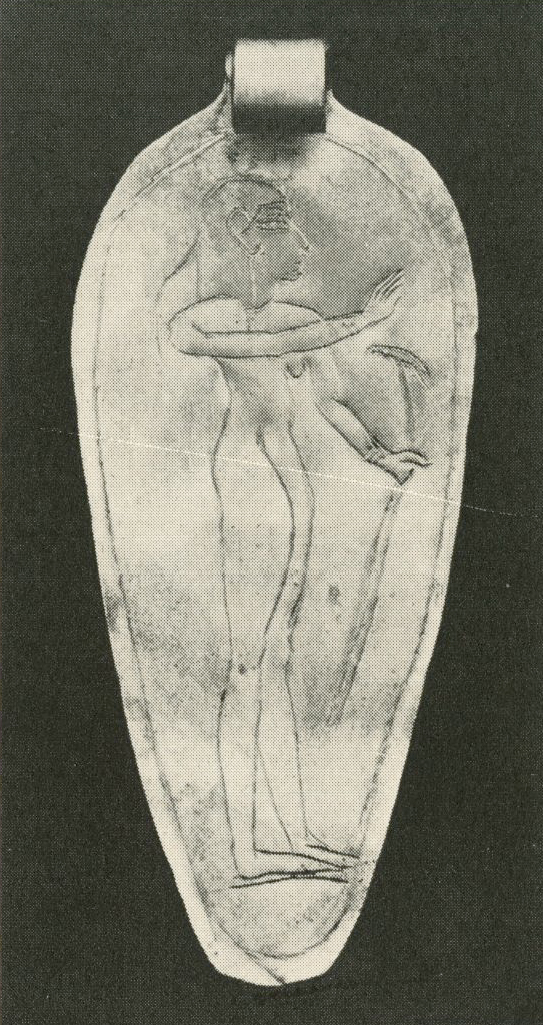
Image Number: 30037
The finds in the courtyard of the Mekal temple are quite varied and numerous and include the following: (1) Pottery objects: (a) Hollow cones with flaring tops. These perhaps once had figures of some description surmounting them. They recall the copper figures of bulls surmounting cones which were employed as votive offerings in early Mesopotamian times.4 (b) A Canaanite open pottery lamp. (c) A Cypriote milk bowl with wishbone-shaped handle. (d) The rim of a flat dish with five gazelles following one another, painted on it in dark red; also some fragments from the same dish, with three gazelles. This dish is unique. The gazelle was usually sacred to the goddess Ashtoreth. (e) Part of a so-called pilgrim bottle with two handles. (f) A rather well-made figurine of Ashtoreth showing the goddess wearing a scalloped headdress and having two bracelets on each wrist; her feet are broken off. (2) Basalt: (a) A crude cylindrical incense altar with its top hollowed out for the incense. (b) A shallow dish for grinding colours; traces of some red colouring matter are still visible in it. A small lump of yellow ochre was actually found in the courtyard but not in association with the grinder. (3) Gold: (a) A flat pendant with a tang at the top twisted over so as to form a loop for suspension. On the pendant is incised the figure of a woman, who is nude except for a headdress of Egyptian type. She holds the was sceptre in her left hand and has her right hand outstretched. From the fact that she bears the sceptre she must be the goddess Ashtoreth, whose figure, once in the form of Antit, the warrior goddess, has often been found on the tell. (b) A lotus-shaped flat pendant with a loop handle of gold wire attached. (c) Another lotus pendant, shaped somewhat like the second example but with a broken tang suspension loop. (d) A fragment of foil. (4) Bronze: Arrowheads. (5) Ivory: A good spindle whorl with an incised geometrical design on its base. (6) Faience and Steatite: (a) A small quantity of faience beads and pendants. (b) A very nice steatite ring seal with a flower design on its hemispherical back and an inscription on its base. The inscription is somewhat corrupt and reads something like, “Gives the king devotion to Ra(?).”5 To the left of the text is the ankh sign of life enclosed in a cartouche. The seal is of XIIIth Dynasty date, about 1780 B. C. (c) A blue faience scarab with the figure of Ptah, the god of Memphis, holding the was sceptre, with the signs of “life” and “stability” in front of him. (d) A Syro-Hittite green glazed faience cylinder seal bearing highly conventionalized figures of animals or birds. (e) A Syro-Hittite blue glazed faience cylinder seal with figures of two crossed stags and a geometrical design. (f) A Syro-Hittite green glazed faience cylinder seal with the figure of a stag, a sacred tree, and a scroll design. (g) A Syro-Hittite white glazed faience cylinder seal showing a sacred tree with a rampant animal of some kind and a divine figure in human form, one on either side of the tree.
It will be seen that the courtyard was by no means barren of finds. The presence of the Syro-Hittite cylinder seals here and elsewhere in the level seems to indicate a northern influence in Beth-shan in the time of Thothmes III.
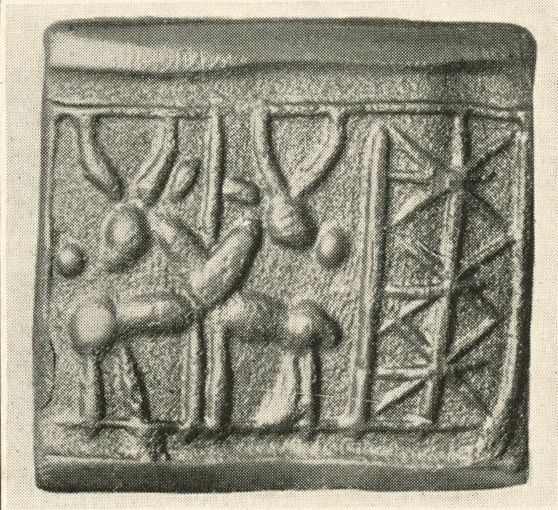
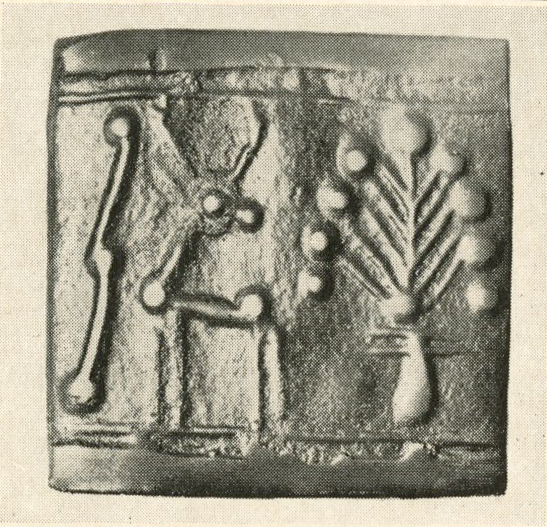
Room with Circular Oven
Immediately to the east of the southern part of the inner sanctuary and of the small room containing the mazzebah or sacred column6 we discovered a large room having its entrance at the south near the mazzebah room. In the northern end of this room there is a great circular fireplace built of stone, about 6 feet 8 inches in diameter and 2 feet 3 inches in depth. Three pieces of bent bronze wire, ashes, charred bones, horns, etc., were found in the fireplace which must have been used for roasting the animals sacrificed in the temple to the deity. That one of these animals was a bull was proved by the excavations of last year. Among the remains in the fireplace there was also the upper portion of a figurine of the goddess Ashtoreth, represented as wearing a wig and supporting one of her breasts with her left hand; the figurine is scorched and seems to have been thrown into the fireplace as an offering. Lucian records that at Hierapolis in Syria, at the spring feast of the great Syrian goddess, various living animals were suspended on a pyre and the whole consumed. The Syrians of Harran, who clung to the ancient Astarte worship far into the Middle Ages, did the same thing.7
From the same room in the Mekal temple came also the following interesting objects: (1) Bronze: A beautiful Syrian dagger, complete, with wood inlay in the handle; arrowheads; and a knife. (2) Pottery: Cypriote milk bowls with wishbone handles; a small bowl containing remains of food, including bone fragments; pots somewhat similar in shape to modern flower pots, each having a hole in its base; a magnificent two-handled jar, 15½ inches in height, decorated with designs in dark red and black; and a bowl with two loop handles inside it. Objects which can be directly associated with the temple consist of the upper portion of a cylindrical cult object with two handles; a part of a serpent (?) cult object; and an entirely unique offering-dish on a hollow stand. This dish has a hole in its base which connects with the stand and was doubtless used for libations. Three cylindrical drainpipes (one broken), unearthed in the southern end of the room, perhaps belong to an intrusive drainage pit built of crude stones sunk in that part of the room, which belongs to the city-level above, i. e., No. VIII or Pre-Amenophis III, 1447-1412 B. c. Drainpipes with handles came from the same level in 1927. Both types of pipes are found in Crete, of Middle Minoan I age (2100-1900 B. c.). From the bottom of the drainage-pit came a flint and also a faience scarab of Thothmes IV. The scarab shows the figure of the king holding an axe and wearing the battle helmet with uræus attached; before him is the cartouche containing his throne name: Ra-men-kheperu. This scarab is of great importance, as it gives further evidence of the correctness of the dating of our earlier levels, for Thothmes IV ruled in the latter part of the period corresponding to No. VIII city-level, which actually represents the reigns of Amenophis II and Thothmes IV. A scarab of Amenophis II was found in the northern cemetery in 1922. These two kings were the successors of Thothmes III, the founder of No. IX city-level; and Thothmes IV was succeeded by Amenophis III, who founded No. VII city-level. (3) Various: A quantity of beads; dishes, corn-mills and grinders of basalt; the horn of a gazelle; and a small opaque white glass seal with a tree-like design on it. Two important objects are a faience scarab and a small limestone amulet having a fish represented on one side and a conventional palm tree of Cretan design8 on the other. The scarab shows a king holding a bow in his left hand, with his right hand uplifted. Before him is a serpent and behind him another serpent and a small tree.
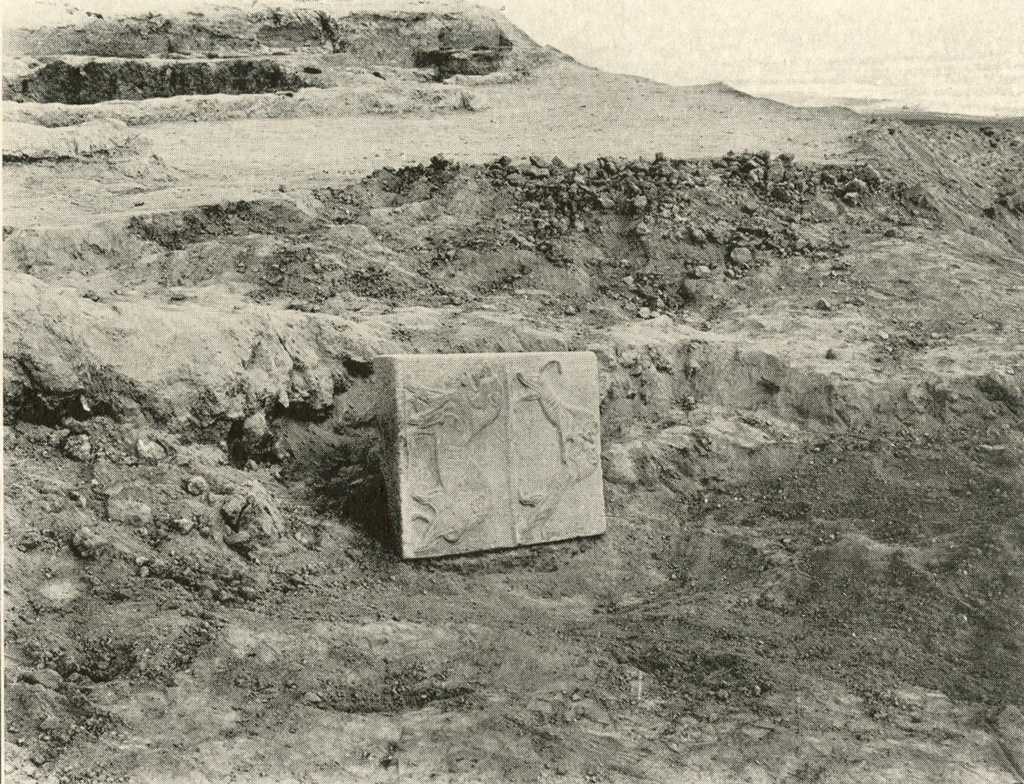
Museum Object Number: 29-107-981
Image Number: 207483, 30155b
Just to the east of the room containing the fireplace is a small room with a well, 43 feet deep and of an internal diameter of 2 feet 10 inches, sunk in it. This Canaanite well, which was made thirty-four centuries ago, is the oldest dated well that I know of in Palestine and was associated with the Mekal temple. Its sides are lined with brick down to a depth of 39 feet from its top, after which they are composed merely of the artificial debris into which the well is sunk. At the very bottom of the well is the original soil covering the low rock knoll on which the tell is situated; this soil is like alluvial sand. The height from the top of the well to the original top of the tell (No. I city-level: Arabic) is 42 feet; so that we now know that the Thothmes III level is actually the half-way point at this part of the mound. No evidence was forthcoming from the debris at the base of the well as to the date of the earliest level of occupation on the knoll. From the well itself came fragments of pottery of various periods, including some of the Middle Bronze Age, and thirty-two flints. Lying on the floor near the top of the well were a few beads of faience and carnelian, some donkey’s teeth, and the solar disk from the head of a faience amulet of the moon-god Khensu.
From rooms elsewhere in the Thothmes III level excavated this season came some lids of alabaster kohl (eye-ointment) jars, a small alabaster drinking cup on a stand, a donkey’s molar tooth, a steatite scarab, and a seal of the same material. The scarab is probably of Middle Empire date (ca. 2000 B. c.) ; it has engraved on it a car-touche bearing the words Kheper-neferui: “The Form (i. e., the king) is doubly beautiful.” Above the cartouche are two ankh emblems of life and the nefer emblem of good luck or beauty; and below, the nub sign of “gold”. On either side is a scroll design. The seal bears on one side of it the throne name of Thothmes III (Men-kheper-Ra) with two ostrich feathers typifying “truth” and, on the other side, the legend : ” The favour and beauty [of] Amen-Ra.”

Museum Object Number: 29-107-981
Image Number: 207484
The Sourthern Corridor of the Mekal Temple
The extreme length of this corridor is about 127 feet while its maximum width, west of the great stepped altar, is 25 feet. It is really one of the most impressive parts of the whole temple and must have looked very fine in ancient times when it was newly built. As we have already seen, a flight of steps, five in all, leads up from the floor of the courtyard to the corridor, the level of which is about 2 feet 8 inches above the level of the courtyard. The southern corridor, containing as it did the great stepped altar and the mazzebah emblematic of the god, was certainly reserved for the priests alone and there must have been a temple guardian stationed near the steps, doubtless in the small room behind the great altar, to prevent unauthorized persons from mounting them. From a panel having lions and dogs represented on it, which was found near the temple and is described in detail below, we know that the mythological guardian of the temple was a fierce hunting dog. Perhaps, then, an actual hunting dog was tied to the peg inserted in the socket found in the southeastern corner of the small room, the leash being of such a length as to allow the dog to reach the far side of the steps. We shall see presently how the Assyrians buried figures of dogs below their thresholds in order to repel the attacks of evil spirits who tried to make entry into the houses. With regard to the temple guardians, we are reminded of a certain Phoenician inscription from Kition, published by Cooke, op. cit., p. 66, which mentions ” The men who have charge of the door [of the temple].”
On the southern side of the corridor near the west end is a part of the great outer fort wall of the Thothmes III level. There is a drain leading from a cement-lined room inside the angle of this wall, opposite the top of the small flight of steps, to a rather deep drainage pit built of undressed stones situated in a small room opening out of the corridor a little to the southwest of the steps, as shown in the plan. Including the room with the drainage pit, there are four small rooms at the extreme western end of the corridor. They were probably used for stores of some kind.
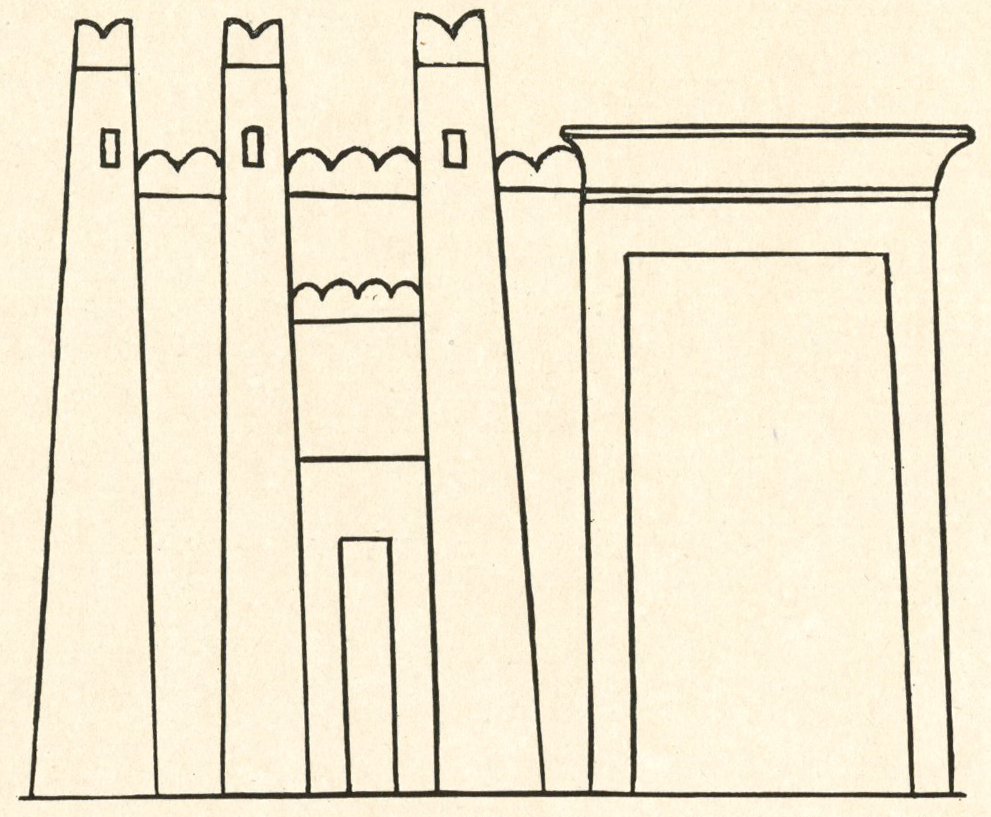
The Great Stepped Altar in the Southern Corridor
This altar, like the rest of the temple, is made of bricks resting upon a foundation of undressed stones. It contains four steps in all, the lowest step being much deeper than the uppermost. There is a balustrade on each side of the steps. The width, over all, of the altar is 16 feet 10 inches and the depth 11 feet 10 inches; its height is about 3 feet. This structure is by far the most remarkable of its kind ever found in Western Asia. That it was connected in some way with the cult of Mekal is quite evident, for the mazzebah and stela of that deity were found in 1927 in the other end of the corridor in which the great altar is situated. Moreover, we discovered this year in the small room behind the great altar, a baetyl or small portable conical stone of basalt, 10 inches high, which is also emblematic of the god.9
Various analogues to the stepped altars in the Canaanite temples of Thothmes III, Amenophis III, and Seti I at Beth-shan are to be seen in Egypt, as for instance at Queen Hatshepsut’s temple at Deir el-Bahari, and in the river temple, tomb-chapels, and private house altars at el-Amarna. These el-Amarna buildings are not unlike our temples of Amenophis III and Seti I, with which apparently, at least in the case of the Amenophis III building, they had some indirect connection. With these may be compared also the entrance stairway of the temple of Nin-khursag at Al-‘Ubaid.10
From various Egyptian representations we see sometimes the king seated at the top of a flight of steps and sometimes a god in a similar position. The Egyptian evidence indicates that the god, like the king, ruled from his seat on the top of the steps and it seems quite certain that the Canaanites of Beth-shan also believed that their deities sometimes dwelt upon the top of stepped altars, from which, no doubt, like their counterparts in Egypt, they ruled over their domains.
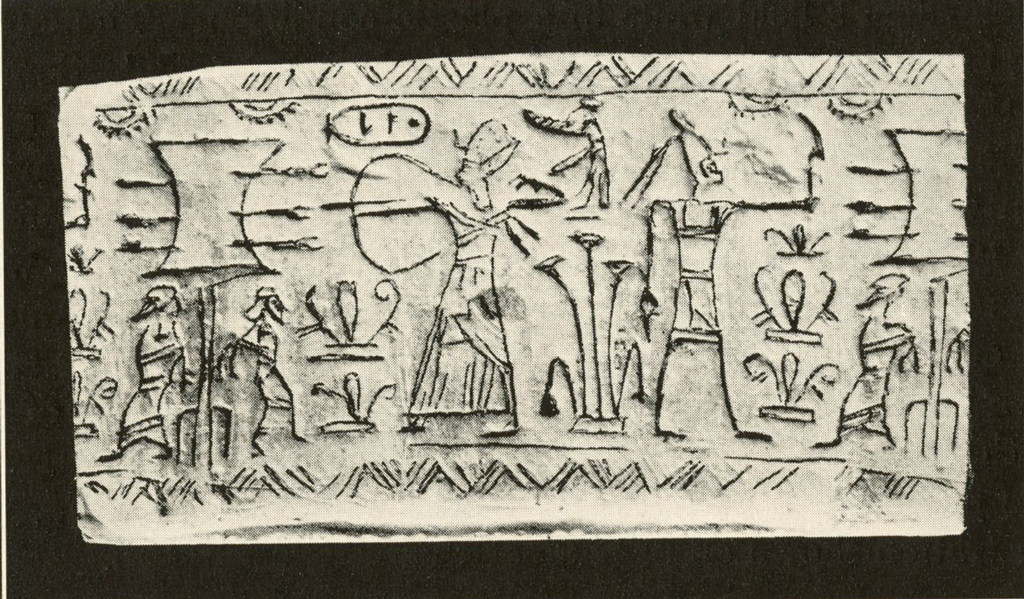
The Room Behind the Great Stepped Altar
Immediately to the north of the great stepped altar in the southern corridor of the Mekal temple is a small room measuring 14 feet 6 inches from east to west and 16 feet 6 inches from north to south. It has two doors, one at the east leading into the great courtyard of the temple and one at the west leading out directly on to the middle of the flight of steps connecting the courtyard with the southern corridor. The south wall of the room is actually the wall against which the great outside altar is built. Running along the north wall and part of the east wall of the room, on the inside, is a low mastabah or “seat”, 1 foot 10 inches wide and 1 foot 3 inches high. As we have already stated above, it seems fairly obvious that the room was intended for the use of the temple guardian, who was possibly accompanied by a large dog.
In addition to the basalt baetyl, there were found in the room a single-spouted Canaanite lamp of pottery, a flint, and an unbored barrel-bead of polished black stone.
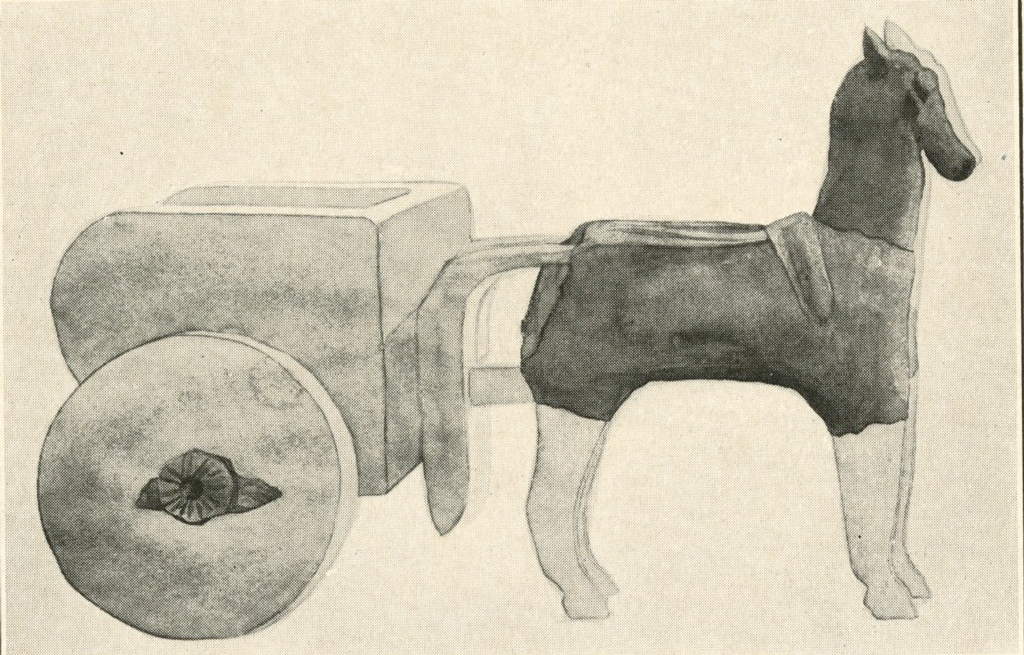
Image Number: 207550
The Great Outer Fort Wall
Immediately to the south of the Mekal temple is the great outer fort wall enclosing the southern end of the level of Thothmes III. For the greater part of its length the wall is a double one, of a maximum width over all of 15 feet 10 inches, with small rooms inside it, as shown in the map. Where the wall is a single one, i. e., at the west end, the maximum thickness is 10 feet. The small room in the west end of the double wall, that is to say, towards the left-hand side of the map, has cement-lined walls and floor and contains in its northwestern corner the top of the drain already referred to in page 45 of this report. To the south of this room is a tower, 15 feet 6 inches wide and 5 feet 9 inches deep, at the maximum. The next room to the east has a blocked door in its north wall, facing the great stepped altar; while the room to the east of that room contains a small cement-lined circular tank, 3 feet 6 inches in diameter and 3 feet 9 inches in depth; this tank has two circular depressions in it and must have been used for water. The next room to the east contains the top of a cement drain, which drain, after running under the northern part of the wall, evidently leads into a pit, as yet undiscovered, situated below the southern corridor of the temple. The exact purpose of these two drains and the tank has not yet been ascertained. At the eastern end of the outer side of the fort wall there are three great towers of a depth of 18 feet 10 inches, the average width of the two outer towers being 4 feet 7 inches and of the inner tower, 7 feet 9 inches. It was in the easternmost of the three bays formed by the towers that we discovered the basalt panel of the lions and dogs.
Other finds from various places to the south of the outer fort wall include the left arm and hand of a bronze figurine; part of an earring of the same material; a cup-and-saucer pottery lamp; and a blue frit scarab showing a uræus attached to a badly made crown of North Egypt, with the bowl-shaped neb sign, usually meaning “lord”, in front.
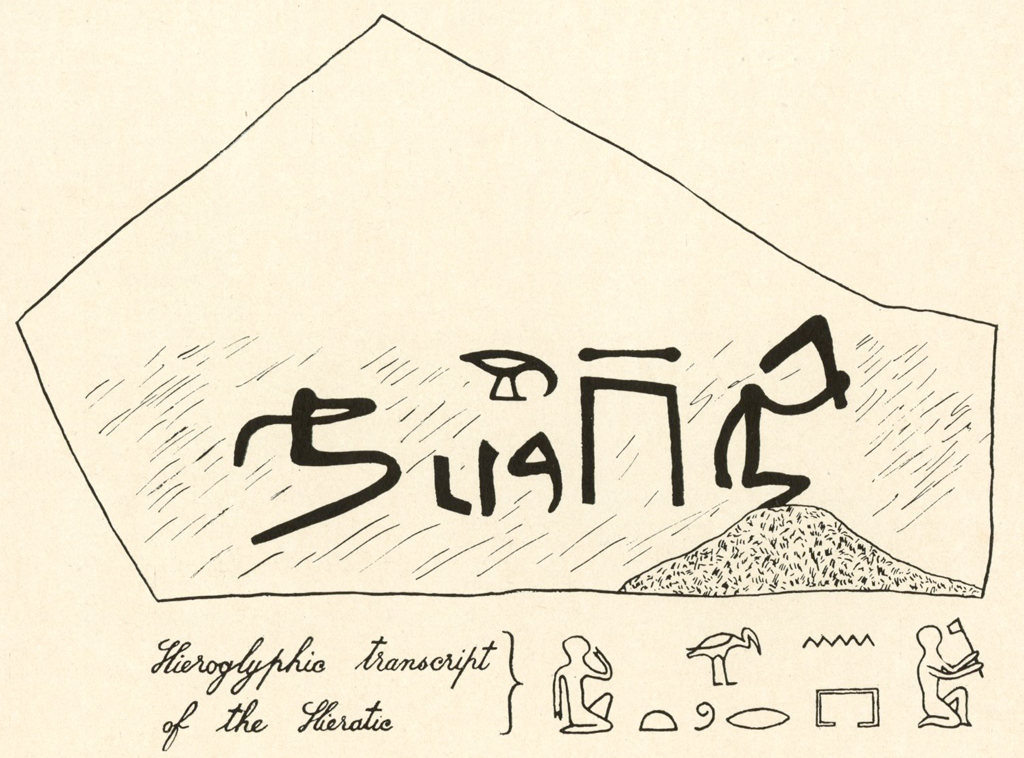
Image Number: 207470
The Panel of the Lions and Dogs
The beautiful basalt panel showing the figures of the lions and dogs was found in the position described above on the morning of the twentieth of November, which is therefore a red-letter day in the annals of the Expedition. This panel was probably originally placed against the door of the Mekal temple, that is, one of the two doors of the inner sanctuary, one of which leads to the courtyard and the other to the outer room at the northeast of the inner sanctuary, as may be seen from the plan. The panel is sculptured in high relief and contains two registers; it is about 3 feet high.
Upper Register: This depicts a lion fighting with a dog. On the shoulder of the lion is a tuft of hair, somewhat resembling a star; a star is usually the indication of a superior being. The lion shows Mitannian and perhaps Assyro-Babylonian influences. A fragment of a stela indicating that Thothmes III fought against the people of Mitanni, a country to the northeast of Syria, was found this year at Tell el-Oreimeh, just northwest of the Sea of Galilee; this stela was published by Dr. W. F. Albright and myself in the Journal of Egyptian Archæology, vol. XIV, November, 1928, pp. 281-287. The lion on our panel evidently represents Nergal, the god of plague and death. As the panel must have been set in the door of the temple, the dog thus guarded the entrance against the lion who brought death and destruction. The dog is like the dogs employed in the hunt, the finest specimens of which are preserved for us in the splendid sculptures in the palace of Ashurbanipal at Nineveh.
Lower Register: This depicts the majestic lion of Nergal being attacked by a dog who is biting his back. The lion has the starlike tuft of hair on his shoulder and is growling in rage. In Biblical times, as we see from Jeremiah, xlix, 19, there were lions in the Jordan Valley. Figurines of the lion have been found in various levels on the tell and the animal in question is represented on one of the shrine-houses discovered near the northern temple (dedicated to Antit-Ashtoreth) in the level of Rameses II.11 The famous ancient Hebrew seal of “Shema’, the servant of Jeroboam”, found many years ago at Megiddo, not far northwest of Beth-shan, shows the figure of a raging lion. Important representations of lions are known from Sheikh Saad and Suweideh in Transjordania and on the famous incense altar of Taanach in Palestine.12 Figurines of dogs came from certain levels on the Beth-shan tell and bricks with impressions of the paws of dogs were found in the Rameses II level.13
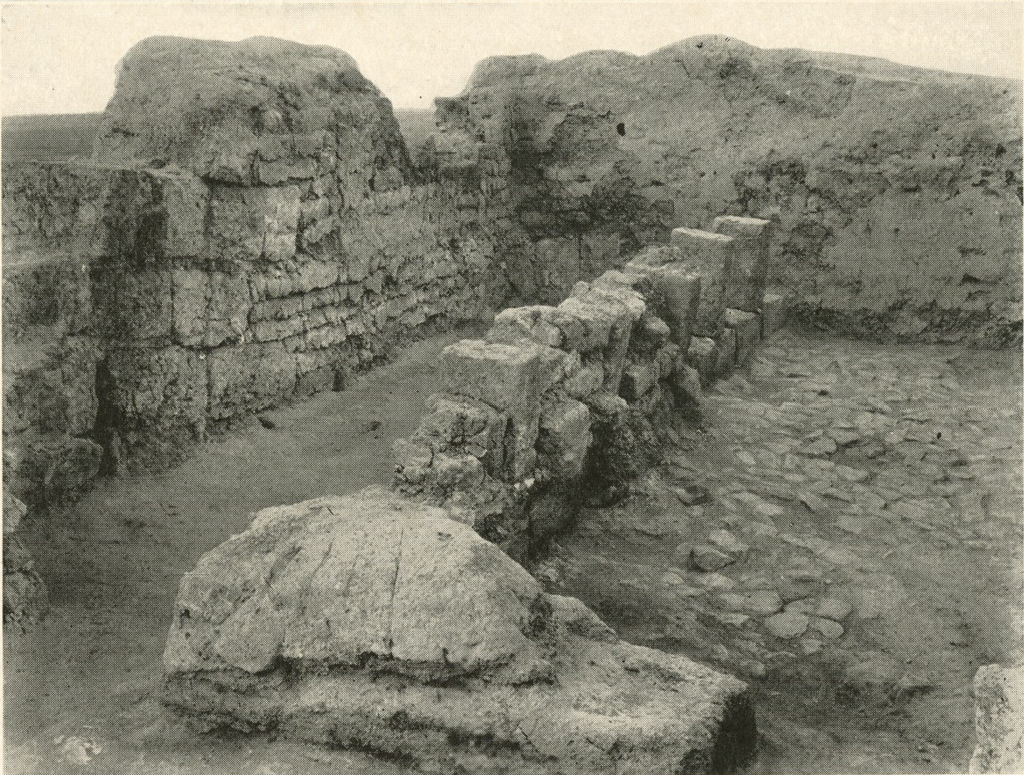
Image Number: 30141
Summing up the significance of the scenes sculptured on the panel, it may be said that the upper register shows the lion trying to enter the temple and the lower register the same animal being driven away from it. It will be noticed that the tail of the lion in the former instance is in the air, and in the latter instance between his legs.
The Assyrians were in the habit of burying figures of dogs under the thresholds of their houses in order that the spirits of the dogs might repulse any evil spirits trying to make an entry into the houses. Five dogs were usually arranged on each side of the doorway and each dog was of a different colour.14 In the British Museum there are five of these coloured dog-figurines, with their names inscribed on their left sides: “Hesitate not, work thy jaws”, “Conqueror of the foe”, “Biter of his opponent”, “Expeller of the wicked”, “The strong of his bark “.15 The names of the third and fourth are surely appropriate to the dog on the Beth-shan panel.
In the el-Amarna correspondence there is evidence that the god Nergal was worshipped in Palestine; the plague is actually called “the hand of Nergal”. A cuneiform seal (ca. 2000 B. C.) found at Taanach speaks of “Atankh-El, the son of Khabsim, the servant of Nergal”.16
Like Mekal, Resheph, and certain other Canaanite deities, Nergal was not only the god of pestilence but also the god of the blazing destructive heat of the sun; and in the code of Khammurabi he is said to “burn his people like a raging fire of swamp-reed.”17 The association between Resheph and Nergal is clearly shown by Albright.18 The emblem of Nergal was the lion, into which, as we see from the so-called Dibarra legends, the god of pestilence changed himself ; and Nergal, the God of the Underworld, appears in the form of a winged lion on a bronze plate.19 A certain text states that on “the 18th of the month Tammuz, Nergal descends into the Underworld; on the 28th of the month Kislew, he ascends again. Shamash (the sun) and Nergal are one.”20 It is a peculiar coincidence that we actually found the panel of Nergal in the month of Kislew! In an exorcism in which the dual nature of the god is further indicated, it is said of Nergal: “Thou shinest in the heavens, thy place is high, great art thou in the realm of Death.”21
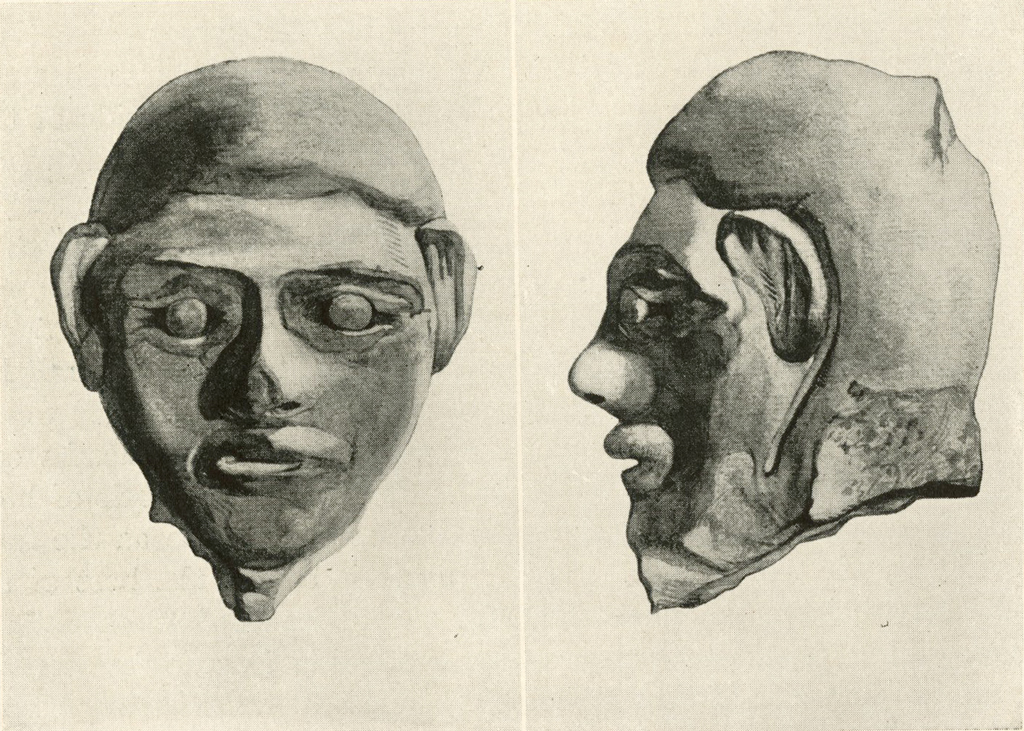
Other Finds in the Thothmes III Level
A number of rooms were found in the area to the west of the courtyard and the southern corridor of the Mekal temple. In one of the rooms was a drainage pit made of undressed stones, with a cement lining covering the floor and walls of the corner in which the pit is situated. Another similar pit was found in an adjoining room just to the north of the outer fort wall. Both pits, when discovered, were covered with rough slabs of stone.
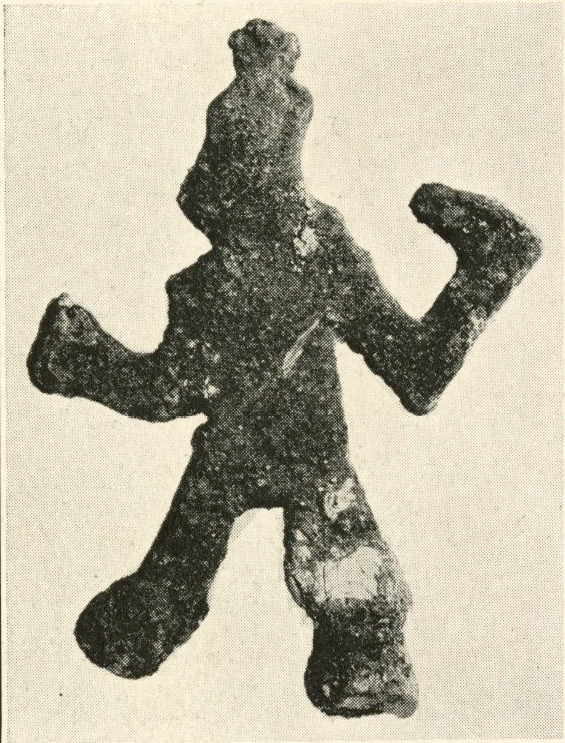
The finds in this western area include the following: (1) Pottery objects: (a) A cylindrical drainpipe, 1 foot 9 inches high, with male and female joints. (b) Dishes with stands. (c) Pots with painted geometrical, palm tree, and other designs. (d) A hollow cylindrical incense cult-object, 2 feet 6 inches high, which like the baetyl referred to on page 45 probably belonged originally to the great stepped altar in the southern corridor. (e) A small model of a pot set inside a bowl. (f) Potstands. (g) A fine goblet on a stand with decorations in dark red. (h) Two figurines of the goddess Ashtoreth, one holding a child in her arms—an unusual type. (i) Part of a flat tray with loop-handle. (j) A pot-handle with a scarab impression, showing the figure of a man with both arms down by his sides. (2) Stone: (a) Part of a limestone parapet projection of a fort wall (see page 54), afterwards used as a mould for bronze daggers. (b) A number of flints. (3) Bronze: (a) A fine scimitar, almost complete. (b) Arrowheads. (c) A small crudely made chisel. (d) A small chain containing several links. (4) Ivory: (a) Two inlays, one with part of an incised decoration on it and one with incised fish-scale design. (b) A hairpin with incised pattern. (4) Glass: A broken figurine of Ashtoreth enceinte, made of opaque green glass covered with white glaze. The goddess wears a headdress and supports her breasts with her hands. (5) Faience, steatite, and lapis lazuli: (a) Faience beads of various kinds. (b) A green glazed faience scarab with its device badly defaced; all that can be seen on the scarab are two neb signs, one above and one below the missing inscription. (c) A light green faience scarab with the figure of a man holding a lotus in his right hand; his other hand hangs down by his side. (d) A white steatite Syro-Hittite cylinder seal showing a figure in human form with crossed arms, an antelope (?), and geometrical designs. (e) A Syro-Hittite or Mesopotamian cylinder seal of lapis lazuli. This bears the figures of two gods and a geometrical design. The cylinder is rather small but is well cut.
From the area to the east of the temple of Mekal came the following scarabs and cylinder seals: (a) A crudely made pale blue glazed faience scarab with defaced device on back. (b) A green glazed faience scarab with the name “Amen-Ra”. Underneath the name is the neb sign and to the left of it a crudely made lotus. (c) A very well made steatite scarab bearing the inscription: “Ra-men-kheper (i. e., Thothmes III), the image of Amen.” (d) A Syro-Hittite blue frit cylinder seal showing a god holding a sacred tree in his left hand. Before him are two stags and scroll designs. (e) A Syro-Hittite white glazed faience cylinder seal showing a line of conventionally made birds with a criss-cross pattern above them.

Image Number: 30204
No. VIII City-Level. Pre-Amenophis III: 1447-1412 B.C.
During the latter part of the season three rooms of the Pre-Amenophis III level were found above and to the west of the great courtyard of the Mekal temple in the level of Thothmes III. In these rooms were unearthed a bronze dagger, a white glazed faience scarab showing the figure of a lion with the ankh sign of life above it, an ivory inlay in the shape of a rosette, and part of the rim of a pot with traces of the bases of certain figurines which were once attached to it. Another room was found above and just to the north of the small room behind the great stepped altar of the Mekal temple.
No. VII City-Level. Amenophis III, ETC.: 1411-1314 B.C.
In No. VII city-level immediately to the west of the area where the great temple of Amenophis III was situated, we have been fortunate enough to discover the almost complete foundations of a great building which appears to be a Canaanite migdol or fort-tower. We have cleared also the foundations of an adjoining building which may well have been the residence of the Egyptian commandant of the fort during the reign of this king. These structures, together with an enormous silo for grain discovered at the same time, are of the utmost importance and are quite unique in the history of our excavations of Beth-shan. The plan accompanying this article shows the relative positions of the migdol, the supposed officer’s residence, and the silo; it also gives on a smaller scale the restored elevations of the western and southern sides of the migdol. The marching soldier depicted in front of the migdol is dressed in the usual uniform of the period. The migdol of Amenophis III is rectangular in shape with its entrance at the west. The entrance was originally flanked by two towers, only the northern one of which is now intact. A similar tower must also have stood at the south-western corner of the fort a little to the right of the tower guarding the southern part of the entrance. Supporting towers such as these are a feature of most Canaanite migdols and forts; two of them were found in the level of Rameses II and will be referred to later on in this report. But whereas the flanking towers of the Rameses II fort are separated from the main building itself, the towers of the Amenophis migdol are actually attached to the walls of the building. From the appearance of the exterior offsets in the northeastern corner it would seem that this particular part of the migdol was also really a tower. The model of the fortified temple which the king presents to the god in the Khensu temple at Karnak likewise has three towers near the gate. The actual entrance of the Amenophis migdol is practically the same as the entrance to the Hittite citadel of Carchemish.22
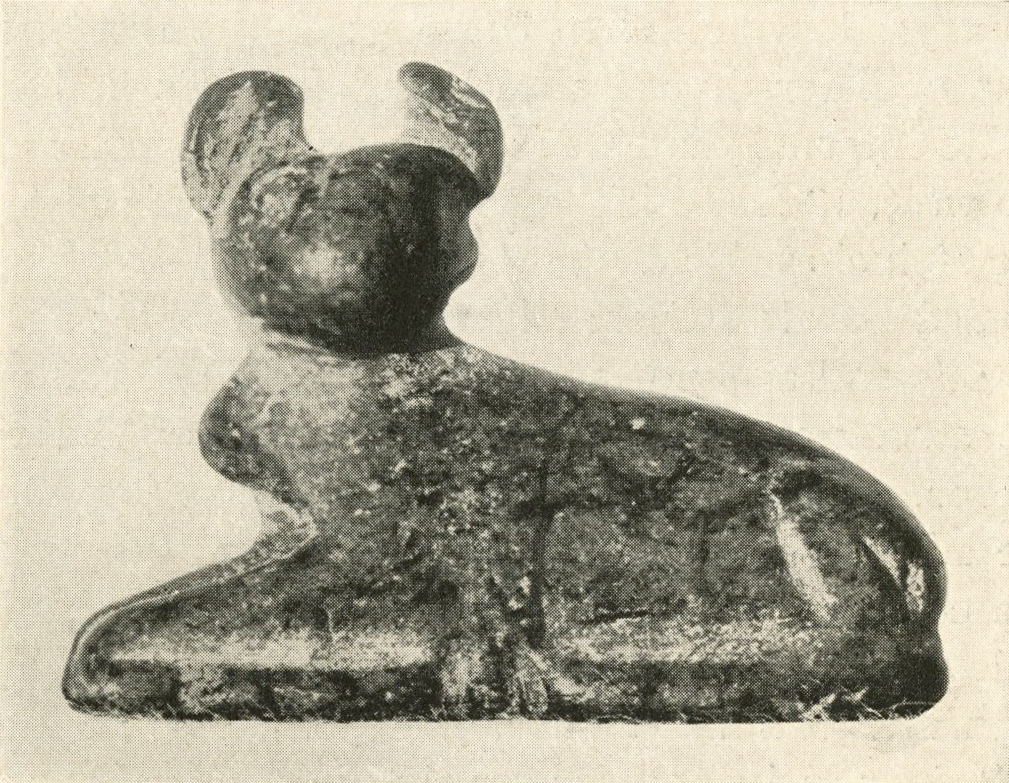
The maximum west to east length of the migdol, including the towers, is 76 feet 10 inches, and without the towers, 68 feet 7 inches; the maximum width from north to south is 50 feet 5 inches. A ramp of beaten earth or stones doubtless once led up to the entrance, the inside measurement of which at the wider part is 14 feet 4 inches and at the narrower part (i. e., at the actual door itself, but not including the door jambs), 6 feet 3 inches. It is rather unfortunate that the whole of the southwestern corner of the migdol should have been destroyed, by the builders of two stone walls of Roman and Byzantine date, respectively; but, in spite of this, the missing portions can be restored on the plan with some probability. As the migdol stands at present it contains four rooms but it is quite evident that there was originally another room, the position of which is indicated in the plan of the building. The L-shaped wall in the room in the northeastern corner is evidently the base of a stairway leading up to the outer wall at the south and it has been so restored on our plan. This southern wall has a very great thickness near the stairway in order, no doubt, to allow of the assembling of soldiers on its top. Taking the average height and width of each step at those of Canaanite steps found elsewhere on the tell, we get approximately thirty-eight steps in all, the topmost of which is about 28 feet from the floor level below. Therefore, allowing for a knee-high narrow parapet, surmounted by a series of cone-like projections of stone running round on the top of the exterior parts of the outer migdol walls and flanking towers, we see that the outer walls of the structure were approximately 30 feet in height.23 We calculate that the towers of our migdol were about 35 feet high.
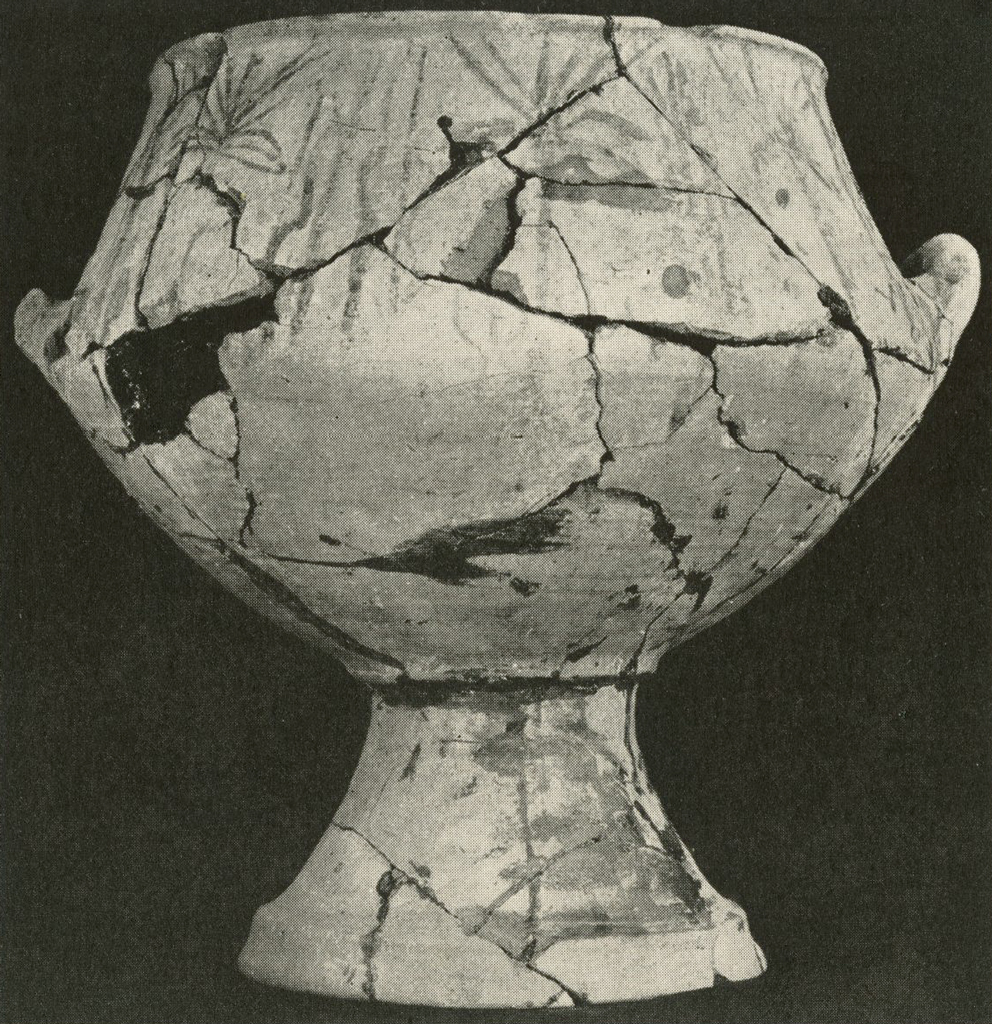
Image Number: 30196
A part of what appears to be one of the projections in question was actually found near the gateway; it is of limestone. The original height of the object seems to have been 13 inches; its thickness is 3 inches, while its width at the base was about 18 inches. When the Egyptians attacked a fort of this description they sometimes advanced to the walls under cover of testudos and shook and dislodged the parapet stones with a species of battering-ram.24
The average width of the outer walls is 7 feet 7 inches, which, with the exception of the outer fort wall in the Thothmes III level, is much greater than that of any Canaanite walls ever found before on the tell. In three places just inside the outer walls themselves, namely, at the northeastern corner, the southeastern corner, and the middle of the southern wall, were found rectangular hollow places filled with huge undressed stones, which were of course employed to strengthen the walls and to prevent breaching. Also it is just possible that a long narrow slot in the outer eastern wall and a smaller slot in the outer wall to the west of the hollow place in the southeastern corner contained pieces of wood for further strengthening the building. Wooden strengthening-beams are found in most Egyptian fortresses in the Sudan and elsewhere but are usually laid transversely in the walls; the Anastasi Papyrus I published by Gardiner in Egyptian Hieratic Texts, i, p. 31, actually refers to beams of this kind. The north wall of the migdol consists for the most part of a large inner wall with a narrow wall built almost touching it on each side; this peculiar feature has not been observed elsewhere. All the walls of the fort are made of sun-dried bricks resting upon heavy foundations of undressed stones, usually basalt. The bricks were generally laid header by header; most of them measured 3 feet 6 inches in length, 1 foot 9 inches in width, and 6 inches in height. A few of them had the impressions on their bases of the dried reeds upon which they were placed in the brickmaker’s field while in a plastic condition. The custom of placing bricks on reeds also obtained in Mesopotamia.25 Somewhere above the fort must have been fixed its emblem, a target attached to a pole and pierced by three arrows. A cylinder seal bearing this emblem was actually found in the Southern Temple of Rameses II in the 1925 season. It is illustrated in this article, and we have used its design in restoring the standard above the Amenophis migdol on our elevations of the building. A very similar standard is shown in an Egyptian representation of the Hittite fort of Dapur, in North Syria, which fort is being attacked by Rameses II. This scene is published by Erman, Life in Ancient Egypt, p. 75, whence the illustration shown on page 86 of this article is taken.
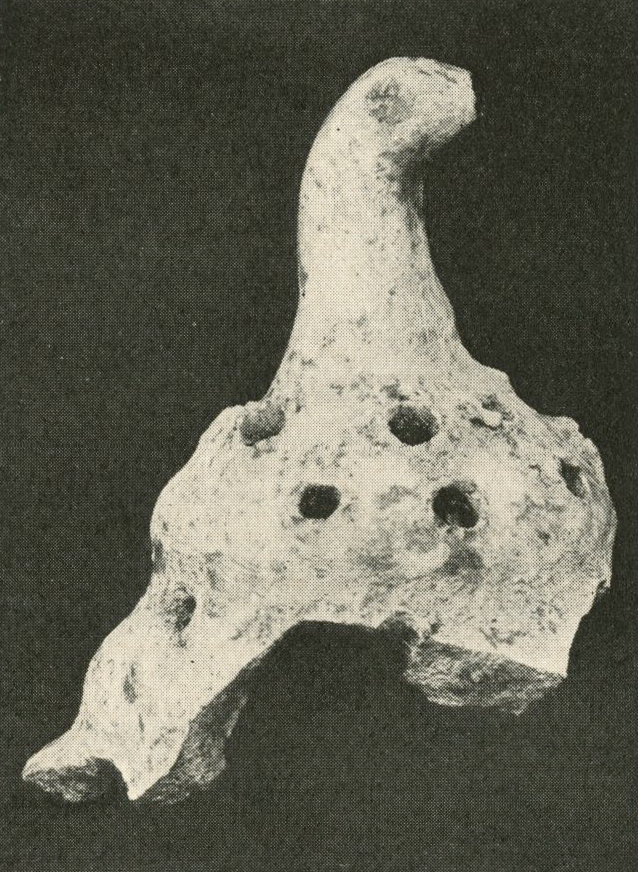
The Commandant and His Troops
The migdol was doubtless meant to form the last place of refuge in the fort for the commandant and his troops in case the outer walls were breached. No traces of outer walls have as yet been found in the Amenophis III level although we know of them in the Rameses II and Thothmes III levels. Some day we may be lucky enough to find the name of the commandant of the migdol as we found that of the commandant of the fort of the time of Rameses II.26 Many of the troops in the fort of Amenophis III consisted, no doubt, of Mediterranean mercenaries, the Sherdenen and others, who were probably officered by Egyptians, although, as we see from the el-Amarna correspondence, the actual rulers of the Canaanite towns were usually local chieftains trusted by the Pharaohs. The mercenaries were buried in anthropoid pottery sarcophagi in the great cemetery to the north of the tell.
From various Egyptian papyri and ostraka we learn that the life of an ordinary Egyptian soldier, particularly in Palestine and Syria, was not at all a pleasant one: “Come, let me tell thee,” reads an exhortation to schoolboys, comparing the pleasant life of a scribe with that of various other professions, “how woefully fareth the soldier; . . . he is brought, while yet a child, to be shut up in the barracks. . . . He is battered and bruised with flogging. Come, let me tell thee how he goeth to Palestine, and how he marcheth over the mountains. His bread and his water are borne upon his shoulder like the load of an ass. . . [He] hath no staff and no sandals. He knoweth not whether he is dead or alive, by reason of the lions. The foe lieth hidden in the scrub, and the enemy standeth ready for battle. The soldier marcheth, and crieth out to his god: ‘Come to me and deliver me!'”27 Even for the Egyptian officers, the life in Palestine or on the frontier between that country and Egypt does not seem to have been an enviable one. The Papyrus Anastasi, for instance, contains the laments of a certain officer who had to erect buildings on the frontier, probably somewhere near the site of the modern Kantarah on the Suez Canal, but who could do no work owing to the fact that, as he says in his own words, ” I am without equipment. There are no people to make bricks, and there is no straw28 in the district. . . . Mine eye glanceth furtively at the road, in order to go up to Palestine. I pass the night under trees that bear no fruit to eat. . . . The gnat (mosquito?) is there in the twilight . . . and it sucketh at every vein. . . . God will deliver whom He will from this fire (i. e., heat), which is here and which hath no compassion.”29 Well may we believe that during the summer months the soldiers in the Beth-shan garrison often expressed sentiments similar to those contained in the last sentence!
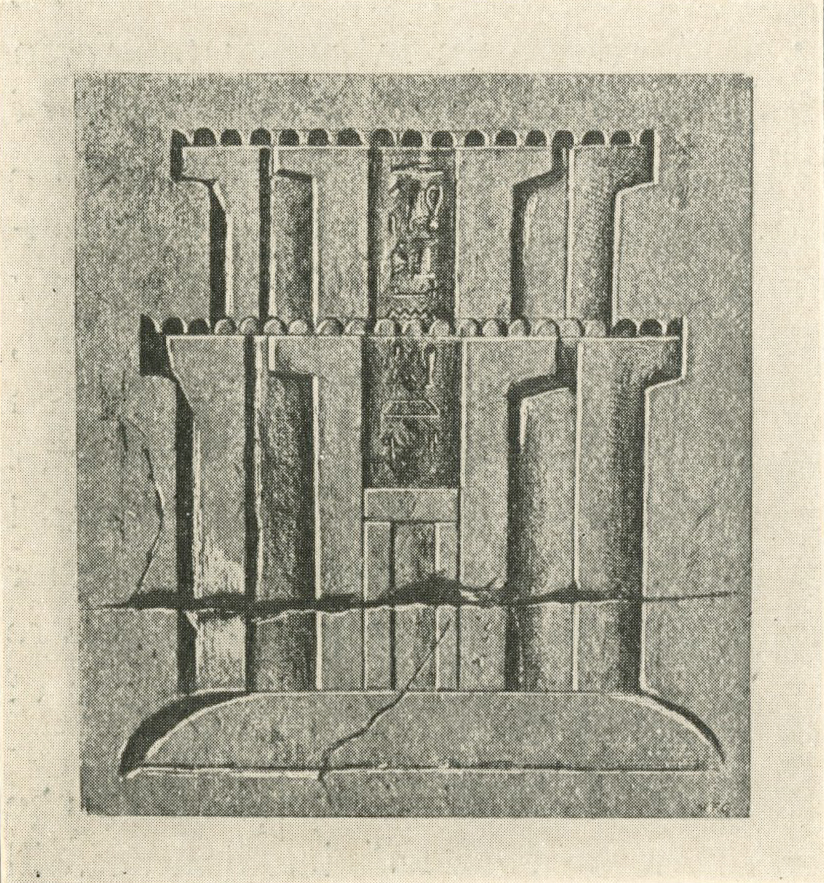
Image Number: 30200a
Hieratic Inscription
Egyptian scribes and craftsmen must also have been installed in the fort. We have actually found the handiwork of one of these scribes, for on a potsherd from the corridor west of the commandant’s residence was written in black ink in the hieratic character the following part of a religious text: Seby (?) en Per-Deshrut, i. e., “The Fiend in the House of the Ruddy Beings.” The Fiend is of course the god Set or Sutekh and the Ruddy Beings are his associates. Among these associates were the hippopotamus, ass, pig, crocodile, serpent, etc. A model of a hippopotamus, coloured a bright red, came from the Early Seti level on the tell in 1926,30 while a cult object surmounted with the head of a pig was found in the southern part of the temple of Amenophis III during the same year. In Chapter CLXXXII of The Theban Recension of the Book of the Dead, Set is actually referred to as the “Ruddy One”. In Chapter XCVI the deceased says, ” I have made Suti (i. e., Set) to be satisfied by means of the spittle of the god Aker and the Ruddy Beings.” Chapters CXLI and CXLVIII mention in connection with the Southern Rudder of Heaven the “Dweller in the Temple of the Ruddy Beings”, which reminds us of the “House of the Ruddy Beings” on the Beth-shan potsherd. Many other references to “Ruddy Beings ” in The Book of the Dead might be given but the above should suffice for the purposes of this article. In passing, it may be mentioned that the above-mentioned potsherd contains the first hieratic inscription brought to light at Beth-shan.

By analogy with a certain recently published collection of pot-sherds containing ink inscriptions cursing all rebels against Egyptian rule, dating from the Middle Empire (ca. 2000 B. C.), we see that the vessel containing the Beth-shan inscription was broken in pieces after the text was written in it, the idea being that just as the vessel was broken so would the fiends be destroyed.31
Model of a Chariot
Although the objects found in the migdol were not numerous, yet some of them are of great interest, especially the fragment of a pottery model of a two-horsed chariot showing the horses, the pole, and the yokes. The trials of an Egyptian official driving a chariot in Palestine are referred to in the Anastasi papyrus: ” Thy horse is gone and is speeding(?) over the slippery ground. The road stretches before it. It smashes thy chariot; . . . thy weapons fall to the ground and are buried in the sand.”32 If the higher officials had difficulties with their chariots, lesser charioteers had far greater ones, for the Egyptian schoolboy was exhorted: “Set thine heart on being a scribe, that thou mayest direct the whole earth. Come, let me tell thee of a miserable calling, that of the officer of chariotry. He is placed in the stable because of the father of his mother (i. e., out of regard for his family), with five slaves; two men of them are given him as helpers. . . . When he hath obtained goodly horses, he is glad and exulteth . . . but he knoweth not yet how it is with him! He expendeth his wealth which he hath from the father of his mother, that he may acquire a chariot. Its pole costeth three deben (273 grammes, probably of silver) and the chariot costeth five deben (455 grammes). . . . He casteth it (i. e., the chariot) away in the thicket, and his feet are cut by the sandals(?), and his shirt is pierced with thorns. When one cometh to muster the troops(?), he is grievously tormented(?) ; he is beaten upon the ground, beaten with an hundred stripes.”33 According to the Koller papyrus, the equipment of an Egyptian war chariot bound for Syria consisted of a pair of horses together with their stablemen and grooms and asses for carrying the provender and bread, a quiver containing eighty arrows, a lance, a sword, a dagger, a whip furnished with lashes, a chariot-club, a “staff of the watch”, a Hittite javelin, a rein-looser, well tested bows, and ” all kinds of weapons of warfare”. The metal weapons were ” of bronze of six-fold alloy, graven with chiselling.”34 What now appears to us to be a stable for chariot horses was discovered in 1923 just inside the northern part of the main entrance to the Rameses II fort on the tell. This consists of a room divided into two parts by a wall of brick containing five upright slabs of basalt to which, no doubt, the horses were tied. Seeing that there are five uprights, we may perhaps assume that the stable contained ten horses, that is to say, five on each side of the wall. The floor, which is paved with undressed stones, was made to slope down from north to south in order that the drainage might be carried away.
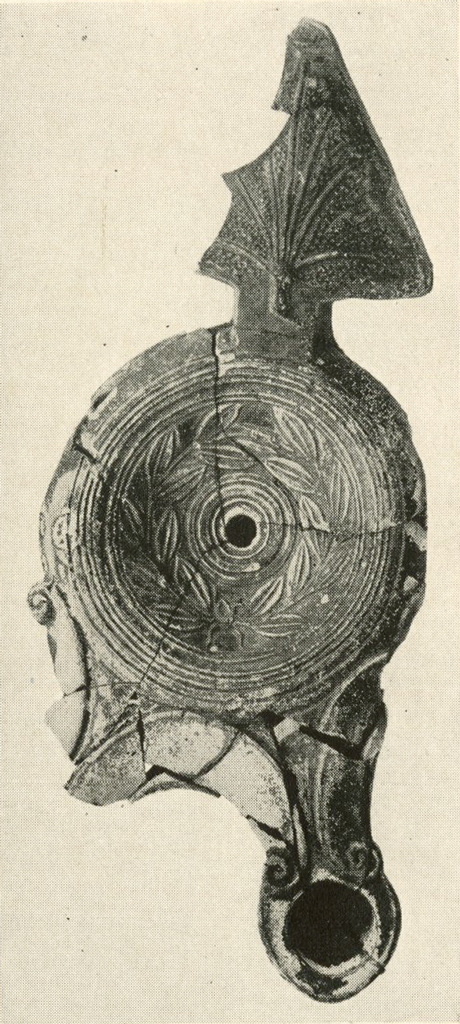
Museum Object Number: 29-102-166
Image Number: 30200
Other Finds in the Migdol
In addition to the model of the chariot, we found in the migdol the well modelled head of a small pottery figurine of a king ( ?) wearing the false beard and having attached to the back of his head what appears to be either part of the uræus or part of the lock of hair symbolic of youth, the former being the more probable as the face is evidently that of a man. This figurine is by far the best of its kind that we have yet unearthed, for the delicacy of its modelling is in striking contrast to the coarse modelling invariably seen in Canaanite portraits of human beings. Perhaps the most important and certainly the quaintest object from the migdol consists of a small jar in the form of a squatting, pot-bellied man, not unlike the Egyptian deities Bes and Ptah-Seker in appearance, with his hands in front of him holding the spout. Traces of a finger impression of the potter are visible on the top of the head. A jar resembling the above but in the form of a woman, came from the archaic Ishtar Temple in Assur (ca. 2700 B. C.), from which temple also came cylindrical cult objects and shrine-houses similar to those found at Beth-shan. Further, the face and arms represented on the Beth-shan pot are not unlike the faces and arms represented on the pottery anthropoid sarcophagi of the foreign mercenaries of Egypt found in the Beth-shan cemetery and also in Lower Egypt. Other finds in the migdol consist of a green jasper amulet of a cat very well modelled (this was a foundation deposit) ; a lid of an alabaster eye-ointment pot decorated with an incised pattern; fragments of Canaanite open pottery lamps; part of a bronze bracelet; a bronze awl with a bone handle; a fragment of gold foil; clay models of votive offering cakes; stone querns and dishes; and a quantity of pottery vessels, including two so-called pilgrim-bottles, a beautiful two-handled amphora with palm tree and geometrical design (this is one of the finest vessels of its kind ever found at Beth-shan), bowls with two loop-handles inside, a small jar with a projecting filter spout, a single-handled jar of buff ware almost egg-shaped, the magnificently decorated rim and shoulder of a large pot, and a cylindrical pot-stand. From the late intrusive debris at the western part of the migdol came a circular single-nozzled pottery lamp of the Hellenistic period, about the fourth or third century B. C.;35 part of a coarse white marble Roman capital; and a cup (broken) of red polished Arretine ware bearing on its base the potter’s name, IVLI, i. e., ” Julius”.
In concluding our remarks on the migdol we must specially mention an object of the very greatest importance which was found in that building and which is almost certainly contemporaneous with it. This is a small, flat, bronze figurine of a god wearing a conical cap. Both arms are uplifted and he holds an axe in his left hand and some other object, now broken away, in his right. That the missing object is the emblem of lightning would seem to be fairly certain, for the god has exactly the appearance of the Hittite storm deity, Teshub, who is generally depicted with both arms uplifted and bearing the axe and lightning emblem.36 Teshub was probably identified with Mekal, the local storm and pestilence god. At the back of the figurine is a horizontal nail-like projection for fixing it to a pole or other object. In view of the assumption that the figurine most probably represents Teshub, it is interesting to recall the Hittite appearance of the door of the migdol;37 also the beautiful bronze Hittite axehead found in the Amenophis III temple on the tell in 1926 and the Hittite seal with hieroglyphs discovered in the same level in 1927.38 At the time the migdol was built and in use a certain amount of Hittite influence was passing into Palestine; for, according to the el-Amarna tablets containing the official cuneiform correspondence between Amenophis III and Amenophis IV of Egypt and their governors in Western Asia, the Hittites were intriguing against Egypt in Syria and there were already Hittite chiefs in Palestine, some perhaps as mercenaries in the Egyptian army.
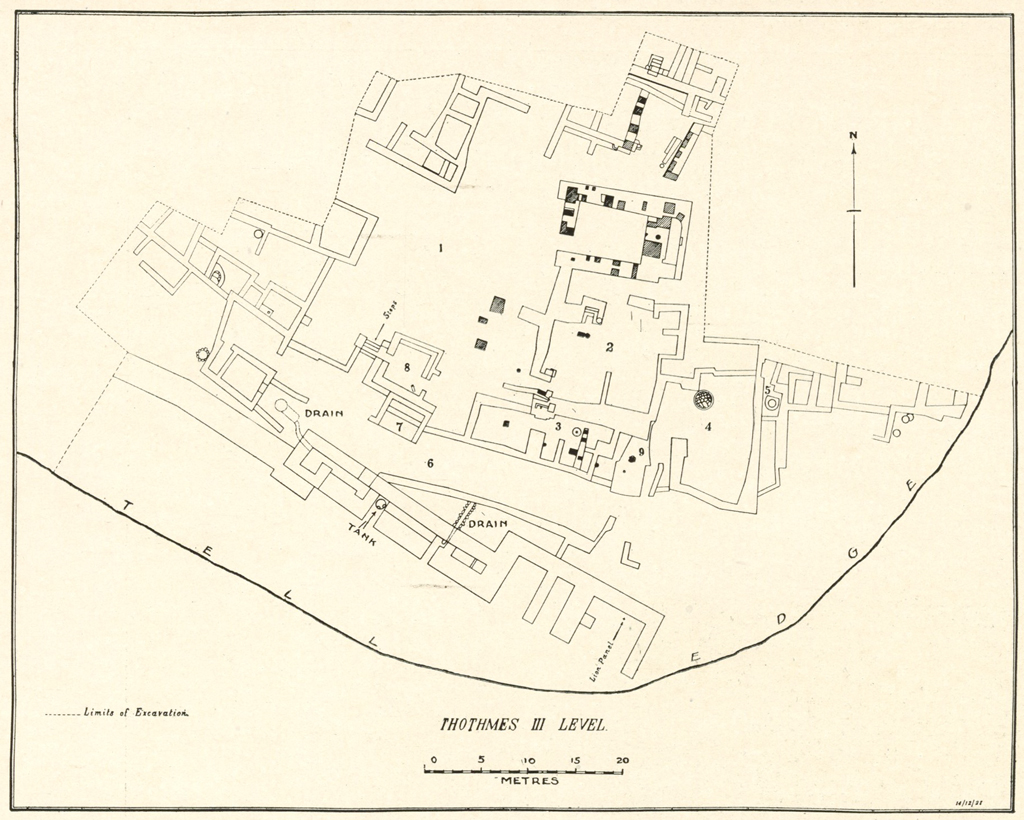
- The courtyard of the Mekal temple, with the tree tables for cutting up the roasted sacrifices
- The inner sanctuary of the temple with the two altars for cult objects and meat offerings
- Room with altar for sacrifice.
- Room with oven for roasting sacrifices.
- Well, 43 feet deep, for supplying water to the temple.
- Southern corridor of temple.
- Great stepped altar, 16 feet 10 inches wide, in southern corridor.
- Small room with two mastabahs or “seats”, doubtless used by the temple guardian. In one corner of the room is the socket for the peg to which, no doubt, an animal, evidently a guardian dog, was tethered.
- Room with mazzebah or conical stone emblematic of the god.
The Commandant’s Residence
As will be seen from the plan of the migdol accompanying this article, the brick building which we suppose to have been the residence of the fort commandant adjoins the northern side of the migdol. This building consists of a rectangular structure with a corridor and three rooms inside it; there is a kitchen on its northern, and an open courtyard containing an enormous granary on its western side. Excluding the outside kitchen and the small wall strengthened by stones projecting to the north of the silo, the residence measures about 40 feet each way and is therefore much smaller than the migdol. Like the latter structure, however, the residence is extremely well built upon a foundation of stones, but its walls are of course not so thick.
Although there are no traces of doors in the residence as it now stands, it seems almost certain that the only outer entrance was at the west end of the corridor at the south of the building, that is to say, in the southeastern corner of the courtyard, behind the silo. Walking eastwards along the corridor one would have found in ancient days a door on the left leading into a room which now appears to us to be a lavatory, the lavatory no doubt being based on the bucket system as at el-Amarna in Egypt. The receptacle for the bucket is at the north end of a narrow brick platform containing a small wall on both sides of it. This is the first time we have discovered a place of this description in Beth-shan. Walking a few steps further eastwards along the corridor one would have come to a second door on the left and a small door straight ahead, the latter leading into a small cupboard and the former into what was evidently the living and reception room. Passing through a door in the north wall of the living room we should have entered a room which was probably used as sleeping-quarters. There is now a small transverse slot in the eastern wall of this supposed bedroom, but whether this was meant to serve as part of a window or whether it was made during the destruction of the building, it is impossible to say.
Among the objects found in the residence itself may be mentioned a quantity of pottery vessels including a pilgrim-bottle, dishes, bowls, and jars; a clenched hand, four and a half inches in length, from a large pottery statue; weights, and a colour-grinding slab, all of basalt; an ivory inlay; a gold bead; a very nice mace-head of alabaster containing a piece of lead in its bore; a well made steatite scarab showing a lioness, a lion, and a bull’s head, all above a crocodile; and a faience scarab bearing the words Amen sankh, i. e., “Amen sustains”.
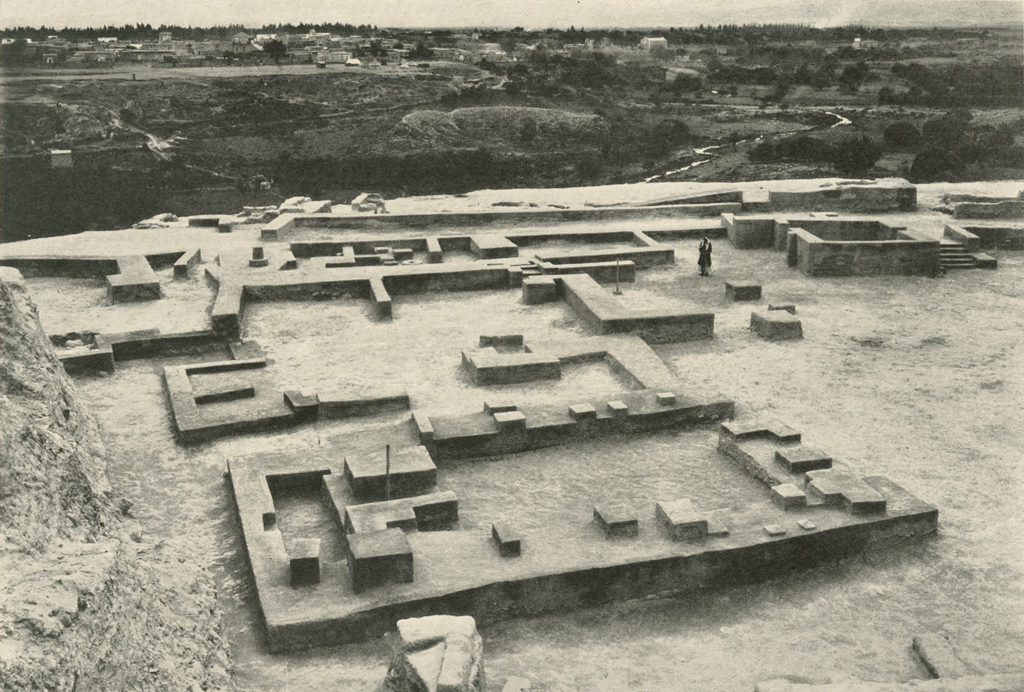
The Kitchen
The kitchen attached to the residence is on the north side of the building and seems to have had its entrance at the west. We found in it the remains of a small circular pottery oven containing ashes; also a jar and bowls, a model of a chariot wheel, models of votive offering cakes, the base of a cylindrical cult object of some kind, the lower part of an Ashtoreth figurine, and a fragment of a very interesting model of a humped bull, all of pottery. The ordinary species of bull as well as the humped species was one of the emblems of the Syrian storm god Adad, whose thunder was represented by the bellowings of the bull.39 Further, as we have seen, the bull was connected with Mekal, the local god of Beth-shan, who was really a kind of storm god. In addition to the above objects must be mentioned a very nice little flower-shaped glass pendant and a basalt plumb-bob.
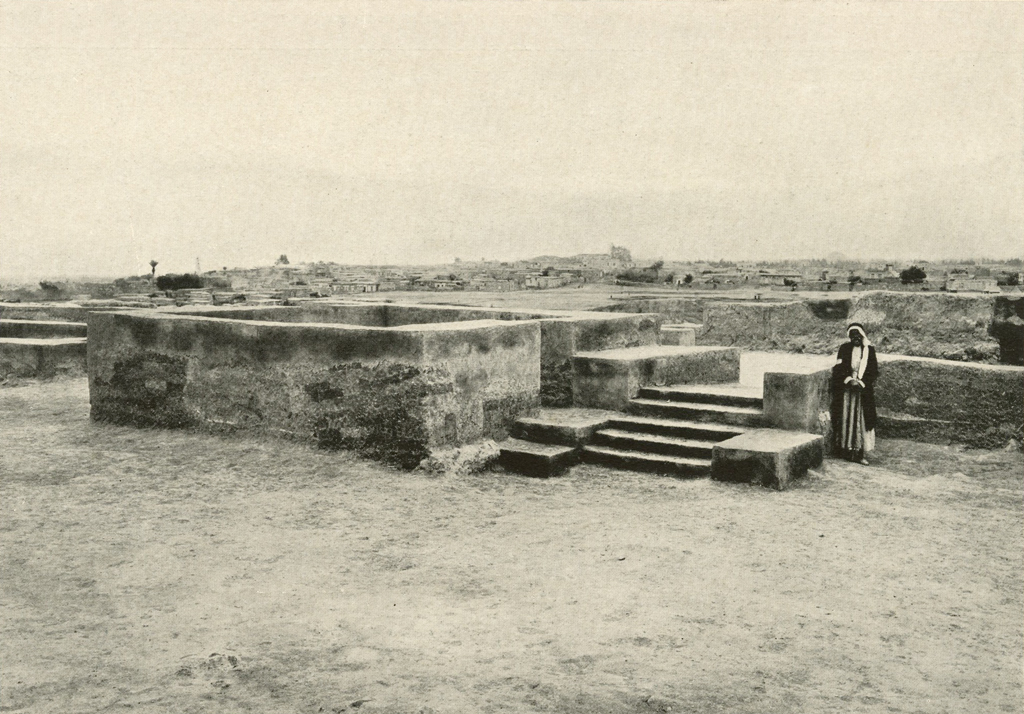
The Courtyard and Silo
The courtyard, which is to the west of the residence, contains an enormous cylinder-shaped silo, built of bricks laid stretcher by stretcher. Its internal diameter from north to south is 13 feet and from east to west, 12 feet 6 inches, while its depth is 11 feet 5 inches; the sides are 10 inches thick. The floor of the silo is of bricks resting upon undressed basalt stones; there are also stones below the circular wall itself and around most of the outside of the underground part of the structure. The present capacity of the silo is 9,270 modern gallons or 8,350 ancient Egyptian gallons (heqat). Although most of the silo as we see it now is underground,39 yet there must have been a considerable part of it (broken away by the builders of the Seti I level) above the ground, which part, judging from the old Egyptian illustrations of silos, was dome-shaped in appearance with a small door in its top for pouring in the grain. Most of the Egyptian silos, however, seem to have been wholly above ground and to have had, in addition to the door in the dome, another door near the base for removing the grain. A very good pottery plumb-bob and a few pieces of pottery, some of which had a white flour-like substance on them, came from the silo. Doubtless, owing to the abundance of water, the valley in which Beth-shan is situated always had excellent harvests. We know, for example, that when Thothmes III, who died thirty-six years before Amenophis III came to the throne, captured Megiddo in the same valley near Beth-shan, he garnered a great quantity of grain.40
In the courtyard itself were found a small bronze dagger with curved blade and studs for the wooden handle, a very highly polished flint, lids of alabaster eye-ointment pots, beads, model votive offering cakes of clay; also bowls with two loop-handles inside, the head of a crudely shaped Ashtoreth figurine with large ears, part of a four-handled cylindrical cult object, and a fragment of another cylindrical cult object with a circular hole in its side, all of pottery.

Image Number: 30170
Rooms East of the Migdol
Just to the east of the migdol and between that building and the southern part of the Amenophis III temple, we discovered about eleven rooms which, judging by their contents, were for the most part storerooms belonging to the temple. The most important object found in them is perhaps an opaque glass scarab showing the figure of a god wearing a conical crown with a pennant attached to the top of it and holding a sceptre in his left hand; he is, no doubt, Mekal, the god of Beth-shan. Other small objects consist of beads, bead spreaders, amulets, all of faience; a bronze pendant having the figure of a hawk on one side and the figure of a lion with two plumes on his head on the other; ivory inlay pieces; a piece of gold foil; heads of models of three pottery geese; a limestone figurine of a monkey playing a pipe; and a limestone whorl having incised on it a sign like a capital M with a perpendicular stroke through its centre. The pottery objects comprise fragments of Cypriote milk-bowls, a good goblet, jars, bowls, and a wheel from the model of a chariot. There were also discovered in some of the rooms fragments of four cylindrical cult objects, one with a circular hole in it; a plaque with part of a serpent modelled on it in high relief; a serpent figurine having a bowl attached to it for the milk which the serpent was supposed to supply; a nude figurine of Ashtoreth with both hands supporting her breasts (apparently once part of a vessel) ; and the trunk portion of another Ashtoreth(?) figurine. All these last mentioned objects are of pottery.
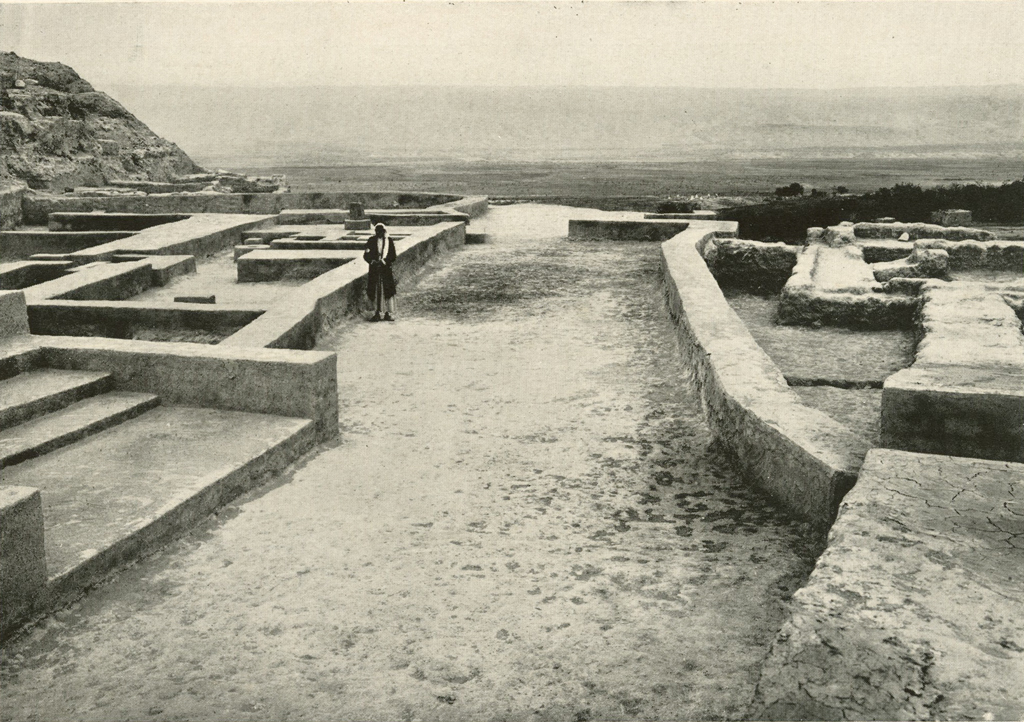
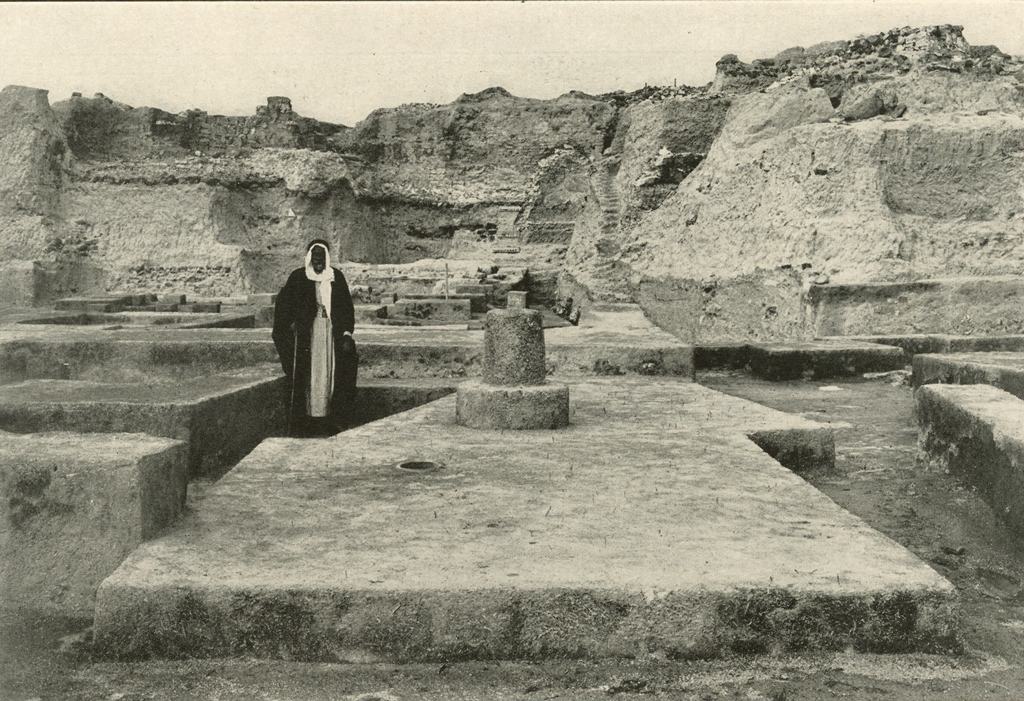
Image Number: 30171
No. VI City-Level. Seti I: 1313-1292 B.C.
Only a few rooms of the Seti I level have been excavated this season; they appear to consist mainly of storehouses. One of them, however, situated immediately to the west of the temple area, had three basalt column bases in it, one base being in the centre of the room and the others covered up by the bricks of the southern wall of the room. The exact significance of these bases is not yet certain but perhaps they originally formed part of a small temporary shrine. When the shrine was no longer required it was destroyed, two of the bases being covered up by a wall. Under the western base we found a piece of gold foil and under the eastern, a fragment of an Ashtoreth figurine. The third base was left in the middle of the room and was perhaps used as a slab for making dough, etc. Near this base was found the lower part of a primitive cornmill formed out of a hollowed piece of basalt; below the base itself was the tooth of an ass. The corn was placed in the lower part of the mill and made into flour by means of a long basalt crusher. A circular hole in the debris indicated where a fourth base was placed. In the northern part of the Seti area just excavated it was found that the Seti walls had been entirely destroyed by the foundations of the walls of the Rameses II level, which, in fact, went down to the level of Amenophis III. In the upper portion of this part of the Amenophis III level were discovered two very interesting objects, one of them being an ingot of heavy metal something like lead in appearance. A piece of lead came from the tomb of Tut-ankh-Amen, while the yellow colour of a piece of Egyptian glass of the XIXth Dynasty was found by Mr. Lucas to be due to its containing a compound of antimony and lead.41 Lead has also been found in Predynastic graves in Egypt.42 Further, the metal was part of the booty captured in Syria by Thothmes III and presented by him to the god Amen.43 Its old Egyptian name was dehti. The other object referred to is a filter of some kind with the head of a goose attached to it. This is entirely unknown elsewhere and may have formed part of a temple object, perhaps a kind of movable filter-stopper for a jar.
The objects unearthed in the Seti I rooms are quite varied and many of them must have originally belonged to the temple in that level. Among the cult objects are fragments of a few cylindrical pottery stands with circular holes in their sides and the fragment of another similar stand with a triangular hole in it. The base portion of a serpent figurine in uræus form and parts of two kernoi or hollow rings with vases on them, all of pottery, are particularly interesting; the kernoi are of course Cypriote in origin. A small crude head of pottery representing a deity evidently comes from some shrine-house similar to those found in the temples in the level of Rameses II in 1925. Among the other important objects from the Seti level are the following: Pottery: A quantity of vessels and objects of various kinds including well decorated Cypriote pilgrim-bottles; a bowl with two loop-handles inside; a hub and the outer portion of a wheel from a pottery model of a chariot; a large eight-handled bowl; a beautifully decorated pot with three loop-handles on its shoulder; a pot containing a quantity of corn blackened by age; and part of a small pottery tray decorated in red with a palm tree and the Cretan double axe. This tray is particularly interesting and the tree on it may be compared with the palm tree on the limestone Cretan amulet mentioned on page 43 as having been found in the Thothmes III level.
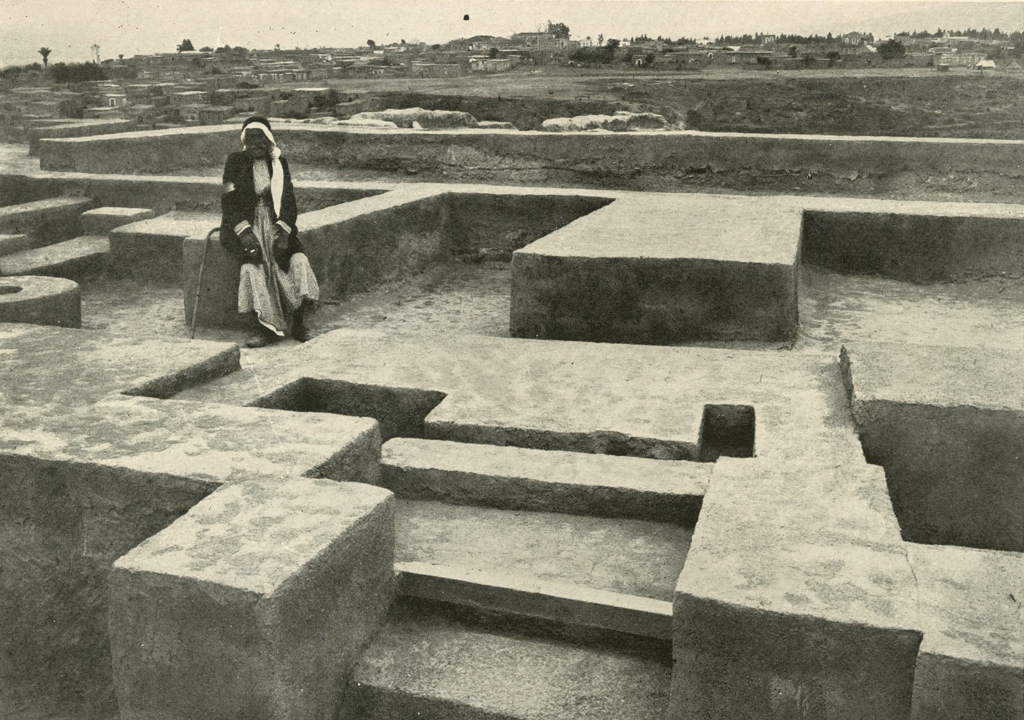
Image Number: 30167
The chariot wheel recalls one of the reasons why the Israelites failed to capture Beth-shan: “And the children of Joseph said, The hill is not enough for us: and all the Canaanites that dwell in the land of the valley have chariots of iron, both they who are of Beth-shean and her towns, and they who are of the valley of Jezreel.”44
A filter-stopper from this level, with its top divided into two compartments, each compartment having three small channels leading downwards from it, represents a type of object hitherto unknown in our excavations. The stopper doubtless served as a “mixer” for two different liquids which were poured simultaneously, each into its own compartment, after the stopper had been fixed into the neck of a jar. A Cretan filter-stopper, consisting of a perforated bulb with a broad collar to fit the rim of a jar, was found at Harageh in Egypt.45
Bronze: A few arrowheads; and the small model of a terrier-like dog carrying a piece of bread (?) in its mouth and having something attached to its back. Bones, etc.: Gazelles’ horns (the gazelle was sacred to Ashtoreth) and the complete upper jaw of an ass. Two of the incisor teeth, of which there are eight in all, were just beginning to grow out of the jaw. The ass was of course associated with Set, the god of storms, etc. Limestone: Three fragments of inscribed Egyptian lintels were found; one of them having traces of a design in high relief on it, one with part of a standing human figure, and one with part of a perpendicular line of hieroglyphs reading: “. . . [fanbearer] at the right hand [of the king], the chief of the bowmen. . . .” All these lintels belonged originally to the monuments set up in the southern temple of Rameses II by the fort commandant, Rameses-Wesr-Khepesh. The above titles are those of his father Thothmes.46 Another limestone fragment from the same temple was found this year in the Rameses II level. On it is depicted part of a standing man with his right arm uplifted. He wears an ornamented collar. Various: Under this heading may be classified beads and some amulets, including an amulet of the goddess Sekhmet and one of the god Bes; an alabaster kohl-pot lid; and two steatite scarabs. One of the scarabs contains two car-touches bearing the throne name of Thothmes III (Men-kheper-Ra), with three ankh signs dividing them. The other scarab shows the figure of an Egyptian king wearing a composite crown on his head and holding a scimitar in his right hand and the hair of a kneeling captive in his left. Before the king is the Wesr sign and behind him the Maat sign, which form part of the throne name of Rameses II (Wesr-Maat-Ra). This scarab is of course an intrusive one from the level above. Two heads from small models of geese, one of ivory and one of alabaster, recall the head of a similar bird represented on the peculiar filter found in the upper portion of the Amenophis III level. The goose, to the Egyptians and no doubt to many of the Canaanites under their influence, was the emblem of Amen-Ra, the sun god.47 From the Seti I level came later on in the season some interesting finds including portions of three cylindrical cult objects, one with a circular hole in it; part of a kernos or ring-stand with two vases on it (originally five) ; a bull’s head from another kernos; and the base of an Ashtoreth figurine; all of pottery. There were also model offering cakes of clay, a brick with impressions of reeds on it, an Egyptian cup of green glazed faience with decorations in black, beads, arrowheads and earrings of bronze, and the model (?) of a small axehead with traces of its wooden handle still adhering to it.
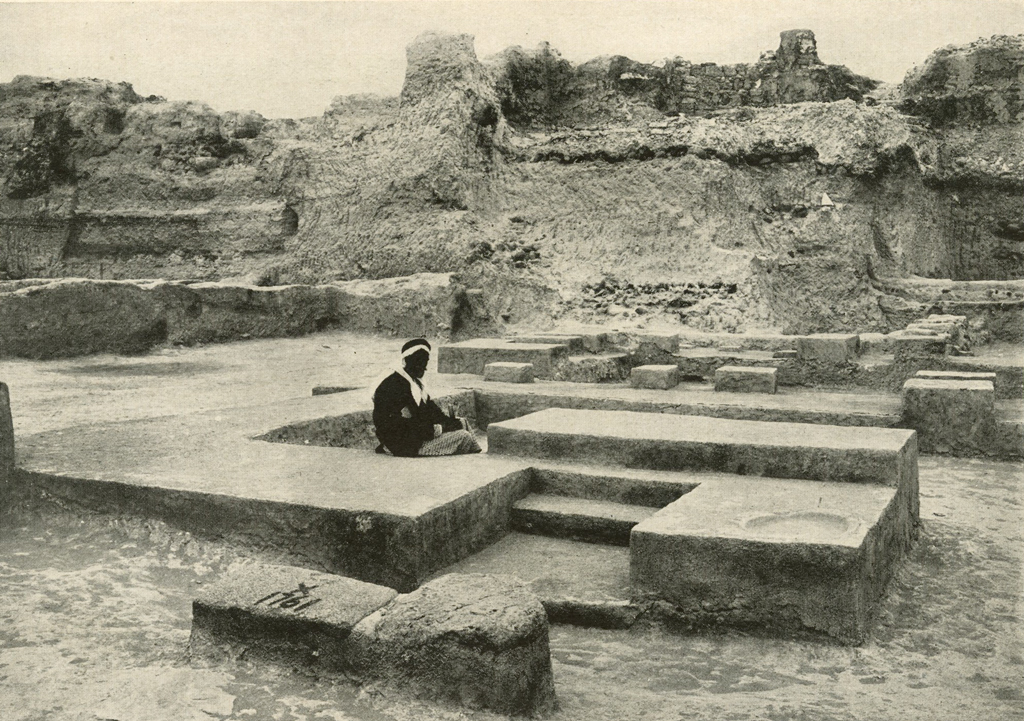
No. V City-Level. Rameses II: 1292-1225 B.C.
After the work in the Seti I level was completed the labourers were transferred to the western part of the fort of Rameses II, where they commenced to clear away the debris from around the main gate of the fort and also the Hellenistic and Roman debris which had intruded into this level at the time of the building and occupation of the great Hellenistic-Roman temple the foundations of which had cut into the walls of the rooms of the time of Rameses II.
The northern part of the Rameses II gate had been partially cleared in 1923 and our present excavations have revealed the fact that there were two solid brick towers on either side of the entrance, thus showing the correctness of the old Egyptian illustrations of Canaanite forts.48 The west gate of the Beth-shan fort of Rameses II is shown in the plan on page 87. Since this plan was made, traces of the southern part of the gateway, restored on the plan, have come to light and it is quite evident that the gate was large enough to permit of chariots being driven through it. The wider part of the inside of the gate is 10 feet 11 inches, or about 6 Egyptian cubits, and the narrower part 7 feet 11 inches, or about 4½ Egyptian cubits. The gate towers are now only about seven feet in height, their upper parts having been removed in ancient times. During a siege the tops of the towers were manned by archers who assisted in the defence of the gate. Behind the towers is the outer west wall of the fort, which is supported by an inner wall; the walls are separated by a narrow corridor. The Canaanite citadel of Jericho had double fortification walls and so had the Hittite citadels of Sinjirli and Boghazkeui.
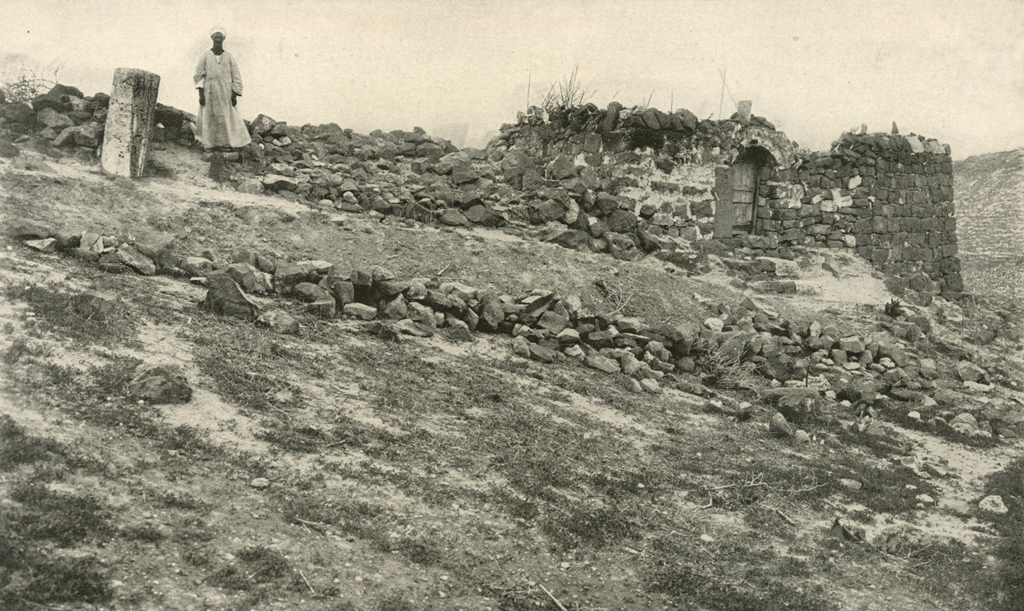
Among the objects found in the Rameses II area which date from the time of that king to a few centuries later must be mentioned three bricks having respectively the impression of the toes of the left foot of a man, the impressions of the paws of a dog, and an incised anchor-like sign; an iron arrowhead; an alabaster circular seal with a wavy-line impression; part of a Cypriote model of a pig or bull; a broken Ashtoreth figurine with two anklets on each leg; a Canaanite lamp; the head portion of a small pottery model of a hippopotamus—the emblem of Set ; a handle of a Cypriote milk-bowl; a magnificent Cypriote oinochoe with concentric circle designs in black; and a roughly cylindrical portable incense altar of basalt with seven flutes or grooves in its sides. A “Græco-Phoenician” oinochoe with a pattern similar to the above but with a handle and a flat base, is shown in A Catalogue of Vases in the British Museum, vol. i, part II, p. 185, fig. 321. The altar is really a debased form of the rectangular panelled basalt altar found in the temple of Thothmes III in 1927.49
Another interesting find was a piece of pottery of the Iron Age with two sets of characters incised on it ; this is illustrated in the present article. The characters have not yet been identified, but Dr. Legrain suggests they are Aramaic. A limestone fragment, evidently of the time of Rameses II, from a Byzantine foundation trench sunk in the southern part of the area has the head of a cow scratched on it and also various lines, etc. ; this looks like the work of a child.
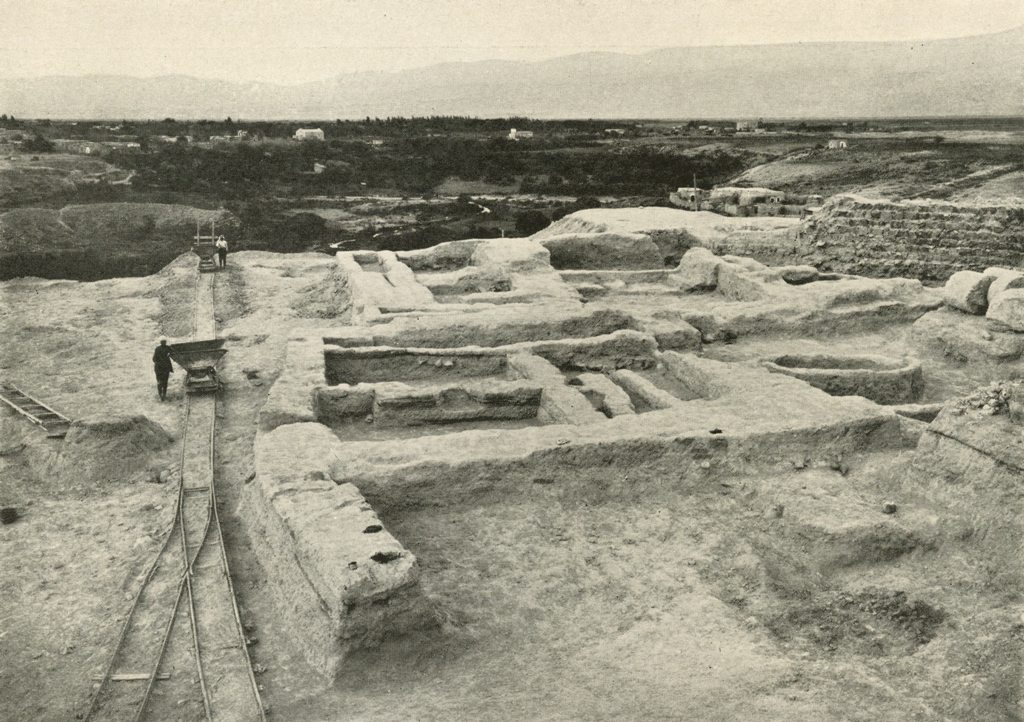
The Roman objects in the area were all discovered in the western part of the Hellenistic-Roman temple where there had been building operations in connection with baths, etc., in Roman times. Among all these objects were two very fine bronze strigils, implements which were employed for scraping off the moisture thrown out upon the surface of the skin by the heat of the vapour bath or by the violence of the gymnastic exercises. About six nozzles of Roman lamps all showing traces of burning, the upper part of a Roman lamp with a dolphin and an anchor in relief on it, and a magnificent Roman lamp dating from between 100 B. c. and 100 A. D., are particularly interesting as showing the types of lamps existing at Beth-shan in later times. The last mentioned lamp had two nozzles, one of which is now missing, and an upright triangular piece with a handle below. On the upright piece is figured the acanthus. Round the filling-hole in the centre is a wreath. There are elaborate volutes between the nozzles. The acanthus is red in colour while the rest of the lamp is of a lightish yellow. On the base of the lamp is the name SELMIS. Another object bearing an inscription is the base
of a Roman bowl of dark red glazed Arretine ware, on the inner side of which is a stamp consisting of the potter’s name, CAMVRI, i. e., C. AMURIUS, in a human foot. The foot stamp seems to belong only to the time of the Empire. Finally, in connection with the later intrusive objects found in the Rameses II area must be mentioned a two-handled Byzantine jar of whitish ware, slightly ribbed, with its rim partially squeezed in before burning. On its shoulder is written in black ink a group of signs in the cursive Greek character; these signs apparently give the name of the pot itself, and are very difficult to decipher as the ink has faded.
Every year’s work at Beth-shan brings forth fresh surprises, for it can be said truly that there has been no season on the site that has not furnished much new information of all kinds—information which is slowly but surely enabling us to withdraw from the mists of antiquity a good deal of the ancient history of the Land of Canaan. Little by little, also, as a result of our excavations, we are beginning to understand better the old religions of the country in which, at Beth-shan, Mekal, Nergal, Resheph, and Ashtoreth in her many forms, all played so large a part.
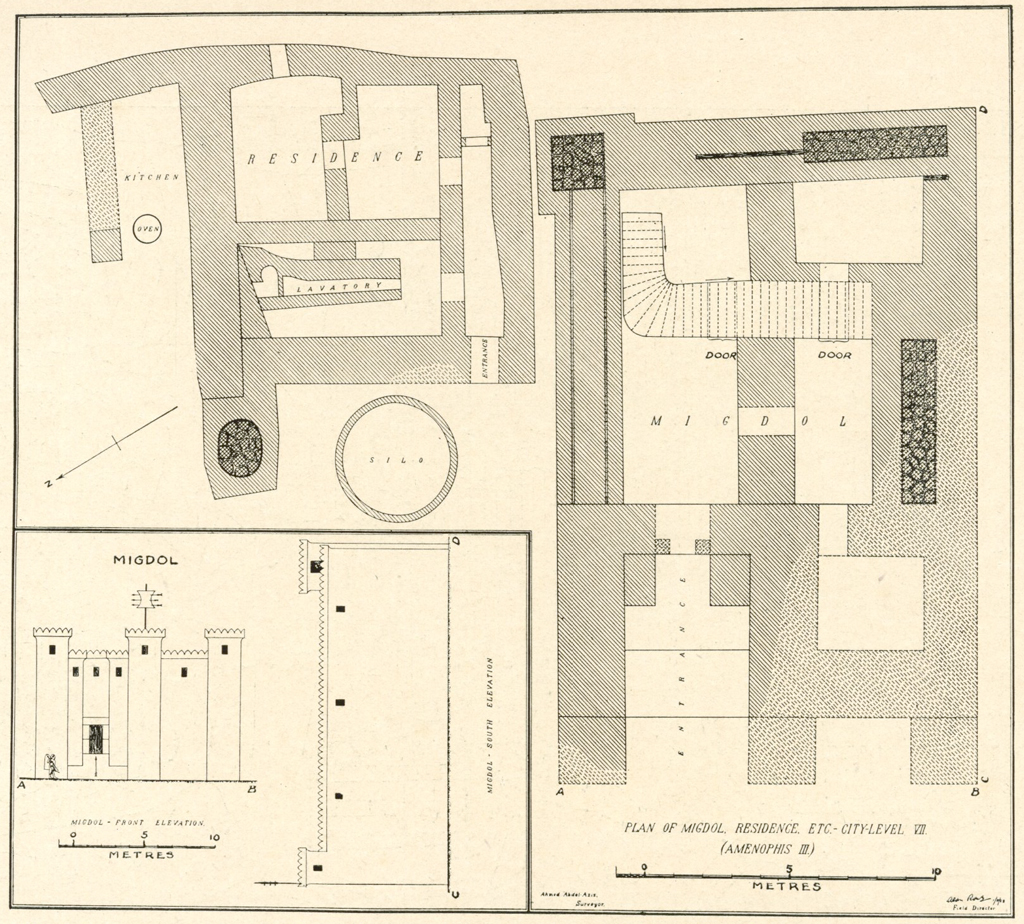
Image Number: 30153
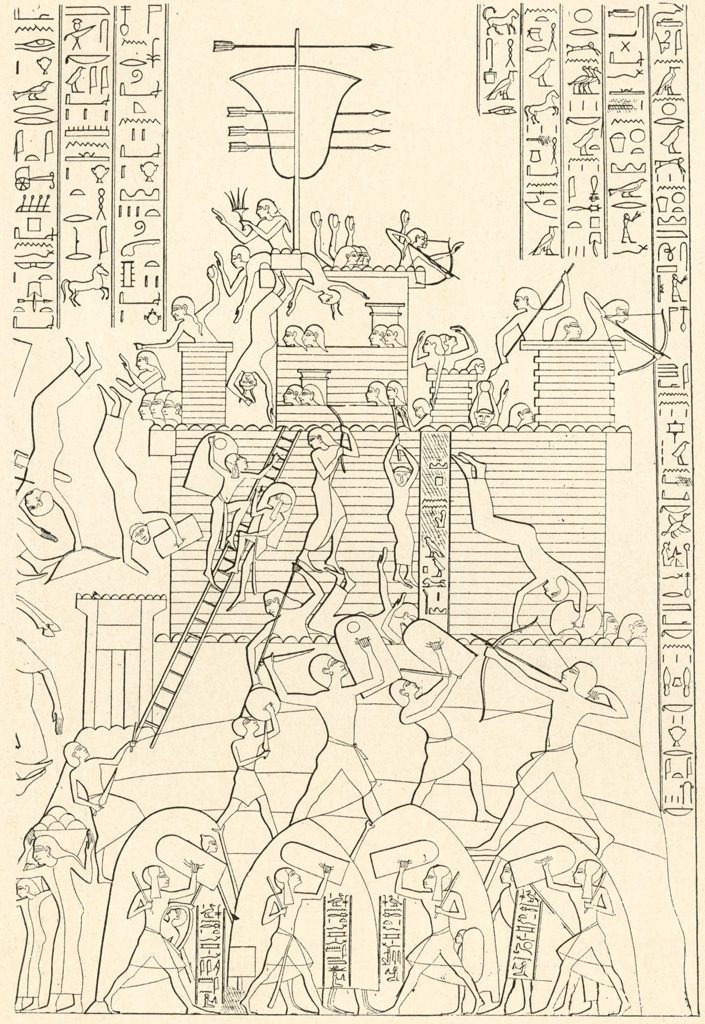
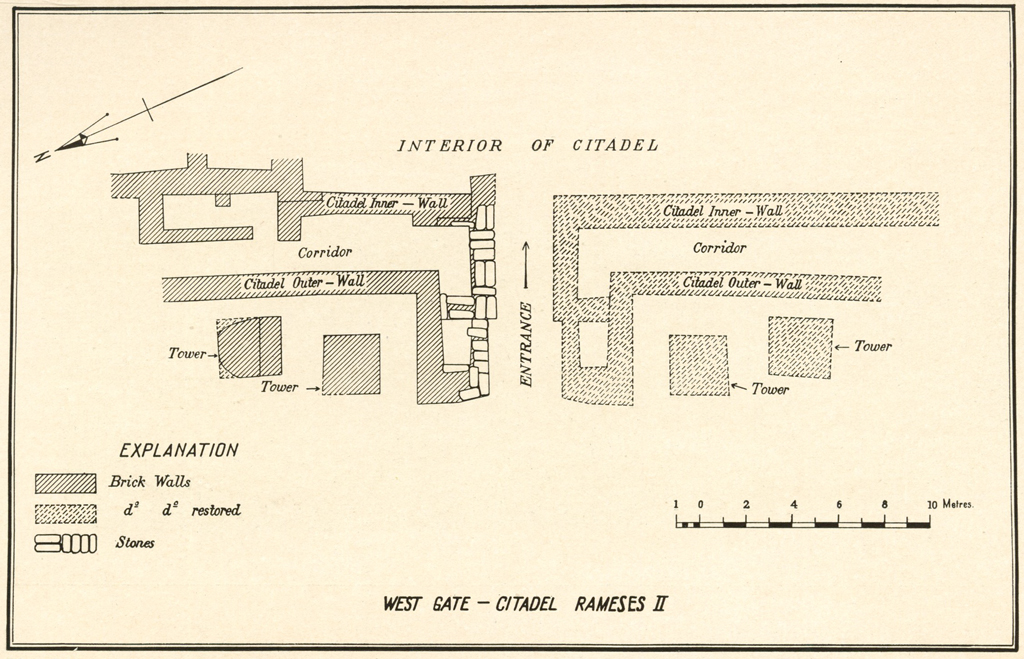
1 Cooke, A Textbook of North-Semitic Inscriptions, p. 130.↪
2 MUSEUM JOURNAL, December, 1927, p. 424.↪
3 Garstang, The Burial Customs of Ancient Egypt, p. 32.↪
4 King, A History of Sumer and Akkad, p. 256, figs. 62, 63.↪
5 Cf. Petrie, Buttons and Design Scarabs, pl. XI, Nos. 608-620, p. 19; and see also the Ra-erdy groups figured by Petrie, op. cit., pl. XII, Nos. 638-644, p. 20.↪
6 See the plan of the temple in this article, p. 75.↪
7 Cf. W. R. Smith, The Religion of the Semites, 3rd ed., 1927, pp. 470, 471. On the significance to the Hebrews of the burnt offering, see J. Hastings, A Dictionary of the Bible, iv, p. 334.↪
8 See Evans, The Palace of Minos, vol. ii, part II, p. 496.↪
9 See Contenau, La Civilisation Phénicienne, pp. 125, 127, on the significance of these sacred conical stones.↪
10 See Jéquier, Manuel d’Archéologie Égyptienne, p. 339; Peet and others, The City of Akhenaten, I, p. XLII, fig. 2, p1. XXVII, fig. 2, etc.; Schäfer & Andrae, Die Kunst des alien Orients, 1925, p. 318; Hall & Woolley, Ur Excavations, I, Al-‘ Ubaid, pl. XXXVIII.↪
11 Figured in the MUSEUM JOURNAL, September, 1926, p. 294. See also the lion represented on the pendant found in the Mekal temple of Thothmes III in 1927. MUSEUM JOURNAL, Decem¬ber, 1927, p. 424.↪
12 Mitteilungen des Deutschen Palästina-Vereins, 1904, p. 2; Vincent, Canaan d’après l’exploration récente, p. 184.↪
13 MUSEUM JOURNAL, June, 1928, p. 167, and p. 68 of the present report.↪
14 Budge, A Guide to the Babylonian and Assyrian Antiquities in the British Museum, 3rd ed., p. 239.↪
15 Op. cit., p. 221.↪
16 Smith, Early History of Assyria to 1000 B. C., p. 337; Jeremias, The Old Testament in the Light of the Ancient East, I, p. 139; Sellin, Tell Ta’annek, p. 28; Clay, The Origin of Biblical Traditions, pp. 46, 47.↪
17 Harper, The Code of Hammurabi, p. 107.↪
18 Mesopotamian Elements in Canaanite Eschatology, Paul Haupt Festschrift, pp. 146 ff.↪
19 Jeremias, op. cit., i, p. 140; Maspero, The Dawn of Civilization, pp. 690, 691.↪
20 Jeremias, op. cit., i, p. 139.↪
21 Loc. cit. The suggestion that the lion on our panel represents Nergal was first made by my friend the Rev. Père Dhorme of Jerusalem.↪
22 Hölscher, Das Hohe Tor von Medinet Habu, fig. 56; and cf. Woolley, Carchemish, II, p. 85. ↪
23 Cf. Maspero, The Struggle of the Nations, p. 128.↪
24 Wilkinson, The Ancient Egyptians, i, p. 242.↪
25 Sayce, Babylonians and Assyrians, 1924, p. 138.↪
26 MUSEUM JOURNAL, December, 1927, pp. 439, 440.↪
27 Erman, The Literature of the Ancient Egyptians, English ed., 1927, pp. 194, 197. The Israel stela of Merenptah, however, indicates that in the time of peace the life of a soldier was not an unpleasant one.↪
28 Cf. Exodus, v, 7-18.↪
29 Erman, op. cit., p. 204.↪
30 MUSEUM JOURNAL, March, 1927, p. 21.↪
31 See Sethe, Die Ächtung feindlicher Fürsten, Völker und Dinge, etc. (Abh. d. Preuss. Akad. d. Wiss., phil.-hist. Klasse, 1926, No. 5).↪
32 Erman, op. cit., pp. 261, 262; Gardiner, Egyptian Hieratic Texts, part I, pp. 27-28.↪
33 Erman, op. cit., pp. 195, 196.↪
34 Erman, op. cit., p. 211; Gardiner, op. cit., pp. 37, 38.↪
35 Cf. Catalogue of Greek and Roman Lamps in the British Museum, pl. XL, No. 43.↪
36 Garstang, The Land of the Hittites, pl. LXXVII, fig. 1; Weber, L’Arte degli Ittiti, pls. 2, 3; and Ward, Seal Cylinders of Western Asia, chap. XLVIII.↪
37 See the reference in footnote 1, p. 54, to the Carchemish gateway.↪
38 Figured in THE MUSEUM JOURNAL, March, 1927, p. 17, and June, 1928, p. 160, respectively. See also the Hittite dagger found in our Thothmes III temple in 1927 and shown in the Quarterly Statement, P. E. F., April, 1928, pl. II.↪
39 Ward, op. cit., pp. 172, 380. Examples of the humped bull have also been found by Petrie at Gerar, in south Palestine. See Quarterly Statement, P. E. F., October, 1928, pp. 213, 214.
↪
40 Cf. Jeremiah, xli, 8, for a Biblical reference to underground stores of grain, etc.↪
41 Breasted, Ancient Records, ii, pp. 188, 189.↪
42 Carter, The Tomb of Tut-ankh-Amen, vol. ii, pp. 171, 175.↪
43 Lucas, Ancient Egyptian Materials, p. 102.↪
44 Breasted, op. cit., vol. ii, p. 223. See also vol. v, p. 140, for other references to lead in ancient Egypt.↪
45 Joshua, XVII, 16.↪
46 Evans, op. cit., vol. ii, part I, p. 212, fig. 119 (No. f I).↪
47 MUSEUM JOURNAL, December, 1927, pp. 439-440.↪
48 See my note on the goose on Canaanite objects in the Quarterly Statement, P. E. F., April, 1928, p. 110.↪
49 Cf. Maspero, op. cit., p. 127.↪
50 MUSEUM JOURNAL, June, 1928, p. 151.↪

